Dr. Tony Phillips
NASA Science News
Tue, 02 Nov 2010 07:10 CDT
This
month, Comet Hartley 2 has put on a good show for backyard astronomers.
The comet's vivid green atmosphere and auburn tail of dust look great
through small telescopes, and NASA's Deep Impact/EPOXI probe is about to
return even more dramatic pictures when it flies past the comet's
nucleus on Nov. 4th.
Another kind of show might be in the offing as well. Could this comet produce a meteor shower?
"Probably not," says Bill Cooke of NASA's Meteoroid Environment Office,
"but the other night we saw something that makes me wonder."
On Oct 16th, a pair of NASA all-sky cameras caught an unusual
fireball streaking across the night sky over Alabama and Georgia. It was
bright, slow, and--here's what made it unusual--strangely similar to a
fireball that passed over eastern Canada less than five hours earlier.
The Canadian fireball was recorded by another set of all-sky cameras
operated by the University of Western Ontario (UWO). Because the
fireballs were recorded by multiple cameras, it was possible to
triangulate their positions and backtrack their orbits before they hit
Earth. This led to a remarkable conclusion:
"The orbits of the two fireballs were very similar," Cooke says. "It's as if they came from a common parent."
There's a candidate only 11 million miles away: Small but active Comet
Hartley 2 is making one of the closest approaches to Earth of any comet
in centuries. It turns out that the orbits of the two fireballs were not
only similar to one another, but also roughly similar to the orbit of
the comet. Moreover, meteoroids from Comet Hartley would be expected to
hit Earth's atmosphere at a relatively slow speed--just like the two
fireballs did.
Cooke
stresses that this could be a coincidence. "Thousands of meteoroids hit
Earth's atmosphere every night. Some of them are bound to look like
'Hartley-ids' just by pure chance."
Even so, he plans to keep an eye out for more in the nights ahead,
especially on Nov. 2nd and 3rd. That's when a potential Hartley-id
meteor shower would be most intense, according to calculations by meteor
expert Peter Brown of UWO.
The comet was closest to Earth on Oct. 20th, but that's not necessarily
the shower's peak-time. Cooke explains: "The comet has been sputtering
space dust for thousands of years, making a cloud that is much bigger
than the comet itself. Solar radiation pressure and planetary encounters
cause the comet and the dust cloud to diverge - not a lot, but enough
to make the date of the shower different from the date of the comet's
closest approach."
If there is a Hartley-id shower - "that's a big IF," notes Cooke--it
would emanate from the constellation Cygnus the Swan, visible to
observers in the northern hemisphere almost directly overhead after
sunset in early November. Lunar interference should not be a problem. On
Nov. 2nd and 3rd, the Moon will be a slender crescent, providing dark
skies for a meteor watch.
"I'll definitely have our cameras turned on," says Cooke. "It's probably
going to be a non-event. On the other hand," he points out, "we might
discover a whole new meteor shower."
Thomas Ashcraft
Lunar Meteorite Hunters
Tue, 02 Nov 2010 15:06 CDT
I did not see any "Hartley-ids" in my all-sky fireball captures this morning. At least no fireball-sized ones.
But I did capture a rip-roaring sporadic fireball. I made a movie of the
meteor with its strong dopplering head echo in stereo at 61.250 MHz and
83.250 MHz. The full radio reflection reflection lasted about a minute.
This movie is only 8 seconds or so, head echo only 1 MB.
Watch Video Here.
Weather Watch is receiving reports of a large light streaking and exploding across the sky in the early hours of the morning.
The fireball was witnessed at 1:45am.
A visitor to Weather Watch described the object as "very fast" and was seen moving in a low trajectory west to east.
"As it passed to the east of us there was a huge ball of flame then
object continued on as it appeared to us earlier when about 7-8 seconds
later another huge ball of flame before it disappeared" says the
visitor, posting an eyewitness report on our Meteors Eyewitness Reports page.
The guest continues to say "Another smaller object could be
seen following a short distance behind" asking if it was possible
satellite debris re-entering our atmosphere.
Comment: This interesting event may be related to the recent fly-by of the Comet Hartley 2 (C/103P/Hartley).
Scientists Watch for a "Hartley-id" Meteor Shower
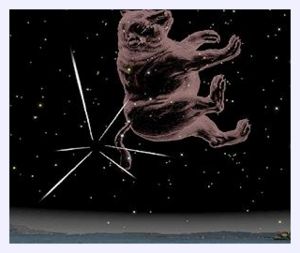
© David A. Aguilar (CfA)
Periodic
meteor showers have been called the bones of comets. The Quadrantid
meteor shower, visible in January, are the remains of an ancient comet
observed by Chinese, Japanese and Korean astronomers 500 years ago.
Periodic
meteor showers have been called the bones of comets. The Quadrantid
meteor shower, visible in January, are the remains of an ancient comet
observed by Chinese, Japanese and Korean astronomers 500 years ago.
Did
Earth encounter pieces of an alien visitor last night? Apparently so!
It appears tiny pieces of Comet Hartley 2 may have presented a
spectacular and startling sky show across the country yesterday.
NASA meteor experts had predicted it was a long shot, but the evenings
of November 2nd and 3rd might display a meteor shower from dust which
puffed off this visiting comet as it passed within twelve million miles
of Earth. And indeed, the Center for Astrophysics has collected several
sightings of bright meteors called fireballs, which result when comet
dust burns up in Earth's atmosphere.
Helga Cabral in Seascape, California, reported after 9 pm last night, "I
saw a bright white ball and tail, arcing towards the ocean. It was
quite beautiful and it looked like it was headed out to sea and so
picture perfect it could have been a movie!" Three thousand miles away
just north of Boston, Teresa Witham witnessed a similar cosmic event.
"I was in the Revere area about 7:15 last night, driving north
on Route 1, when a brilliant object with a tail passed in front of me -
very similar in appearance to a shooting star but it appeared much lower
to the Earth than a typical shooting star would be. If it weren't for
the fact that I had my daughter with me, I'd begin to believe I'd
imagined it."
Comet Hartley 2 has put on quite a nice show for amateur astronomers
over the past few weeks, sporting a vivid green coma or halo around it
and a golden auburn tail of dust. NASA's Deep Impact/EPOXI probe will
present dramatic close-up images of the comet when it zooms past the
nucleus on November 4th.
When a comet approaches the Sun, it heats up unevenly, throwing off
dust, ice and bits of rock. When the Earth encounters some of this space
debris, it is seen as a beautiful meteor shower.
"Many people don't realize that the famous periodic meteor shower in
August, the Perseids, is the remains of Comet Swift-Tuttle and the
Orionids, appearing in late October, are leftovers from Comet Halley,"
said Tim Spahr, Director of the Minor Planet Center at the
Harvard-Smithsonian Center for Astrophysics in Cambridge, MA.
So for the next two evenings, we may see more of Comet Hartley 2. And if
you have dark skies and a small telescope or binoculars, try to find
Comet Hartley 2 itself. It will be near the bright star Procyon in the
constellation Canis Minor near Orion the Hunter, which will be high
overhead in the early hours before dawn.
Smithville, Tennessee - A Smithville man witnessed something only 1,000 people have ever experienced.
In August, while walking down the street in Smithville, Jimmy Duncan and his girlfriend, heard and then found a meteorite
"My girlfriend and I were walking down the street and we heard an awful
whistle," he recalled. "We looked around to see and all of a sudden, I
heard a thump."
The meteorite had hit the asphalt pavement, left a hole and then bounced onto the sidewalk.
Duncan knew what it was, but had no idea how rare his experience actually was.
Of all the meteorite findings around the world, just over 1,000 cases
are called "falls" or situations where people witness the meteorite
hitting the earth.
"It missed me by about 10 feet," Duncan said.
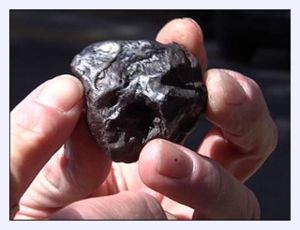
© WKRN.com
As NASA's Deep Impact (EPOXI) probe approaches Comet Hartley 2 for a close encounter on Nov. 4th, mission scientists are certain of only one thing:
"We're about to be surprised," says principal investigator Mike A'Hearn
of the University of Maryland. "This comet is unlike any we've visited
before, and we don't know what we're going to find."
In recent years, international spacecraft have buzzed the cores
of four comets: Halley, Tempel 1, Borrelly and Wild 2. Deep Impact even
blew a hole in one of them (Tempel 1) to see what was beneath the
surface. Those previous flybys, however, may not have prepared
researchers for the comet at hand.
"Comet Hartley 2 is smaller yet much more active than the others,"
explains A'Hearn. "Although its core is only 2 km wide - about a third
the size of Tempel 1 - it is spewing five times more gas and dust."
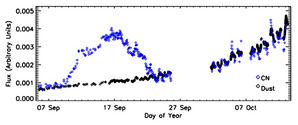
The
comet has already shocked the science team by producing a massive surge
of CN, the cyanogen radical commonly known as "cyanide." Cyanide itself
wasn't the surprise; CN is a common ingredient of comet cores. Rather,
it was the size and purity of the outburst that has researchers puzzled.
"The abundance of CN in the comet's atmosphere jumped by a factor of
five over an eight day period in September - that's huge," says A'Hearn.
"Curiously, however, there was no corresponding increase in dust."
This flies in the face of conventional wisdom. Comet cores are thought
to be a mish-mash of volatile ices, rock, and dust particles, generally
well mixed. When the ice evaporates to produce a jet of gas, dust
naturally comes along for the ride. Yet this outburst was pure gas.
"We have never seen this kind of activity in a comet before. The amount
of gas suggests a global event - but how could such an event occur
without dust? It's a mystery."
A'Hearn stresses that readers shouldn't worry about a "poisonous comet."
For one thing, Comet Hartley 2 is more than 11 million miles from
Earth. There's no direct contact between our planet and the comet's
gaseous shroud. Furthermore, the cyanide gas is very diffuse. If it did
touch Earth, it would not be able to penetrate our planet's dense
atmosphere.
May of 1910 provides a relevant example: Astronomers had just announced
that Earth was passing through the cyanide-containing tail of Comet
Halley, triggering a minor panic. People walked the streets of New York
wearing gas masks, and unscrupulous merchants made a pretty penny
selling "comet pills" to counteract poisoning. Nothing happened. Even
direct contact with Halley's tail produced no ill effects.
The real significance of Hartley 2's cyanide surge is the tease.
Something mysterious is happening ... and we're about to find out what.
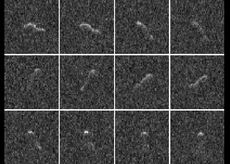
The
flyby officially begins on the evening of Nov. 3rd when Deep
Impact/EPOXI is about 18 hours from closest approach. During the early
stages of the encounter, all of the close-up images will be stored
onboard the spacecraft. This is because Deep Impact cannot
simultaneously point its high gain antenna toward Earth and its imagers
toward the comet.
Closest approach occurs around 10 am EDT on Nov.4th at a distance of 435
miles. About a half an hour later, the changing geometry of the
encounter will allow simultaneous communications and imaging. With its
big antenna once again pointing toward Earth, Deep Impact/EPOXI will
begin transmitting close-up pictures of Comet Hartley 2. The complete
data dump will take several hours.
"We will be waiting," said A'Hearn. "The best images won't reach Earth until many hours after the actual encounter."
Data from the close approach will continue to download through the 6th
of November, but NASA will release preliminary results sooner than that.
A live press conference is scheduled for 4 pm EDT (1 pm PDT) on Nov.
4th.
Stay tuned to the EPOXI web site for updates.
Deep space COMET FLYBY: First PICS
Empty NASA space bomber in recce pass against 2nd target
NASA's former Deep Impact comet-bomber space probe, since renamed EPOXI*
and reassigned to rendezvous with a second space snowball, has made a
successful close pass by the comet Hartley 2.
"The mission team and scientists have worked hard for this
day," said Tim Larson, EPOXI boffin at NASA's Jet Propulsion Laboratory
in California. "It's good to see Hartley 2 up close."
According to space-agency spokesmen, "preliminary indications" are that
EPOXI was about 700km from Hartley 2 at closest approach, roughly what
had been planned. This was at just before 2pm UK time, and since then
pictures and data have been beaming down from the craft to NASA's Deep
Space Network receivers.
The Deep Impact spacecraft lifted off from Earth in January 2005,
rendezvousing with the comet Tempel 1 in July that year and successfully
smashing an impact probe into it, gaining valuable data on the makeup
of the comet. NASA then assessed that the probe still had plenty of
manoeuvring fuel left and that, by means of judicious low passes above
Earth, it could be steered to a new rendezvous with another comet.
The most recent gravity-assist low pass above Earth took place in June,
with the spacecraft picking up an additional 3,470mph of velocity as it
zoomed just 19,000 miles above the South Atlantic before heading out
into space once more in pursuit of Hartley 2.
There will be further briefings on the Hartley 2 pass later on NASA TV: full details and some more early pics can be seen here.
BOOTNOTE*
EPOXI - Extrasolar Planet Observation and Characterization plus Deep Impact Extended Investigation
Montreal - Great balls of fire have been reported swooping over Eastern Canada and several U.S. states.
Even NASA's on the case.
There are different theories about what was behind the sighting of those
fireballs. A NASA spacecraft got a closer look at one of the possible
sources today.
The spacecraft flew past Hartley 2 -- taking closeup pictures after the comet made one of its closest passes by Earth this week.
But one expert is skeptical of reports that any fireballs came from
Hartley -- which is roughly 1.2 kilometres wide and spews deadly cyanide
gas.
Scientist Peter Brown says his meteor group at the University of Western
Ontario tracked one of two fireballs while the other was tracked by
NASA's Meteoroid Environment Office.
Dr. Tony Phillips
NASA Science News
Thu, 04 Nov 2010 06:33 CDT
As NASA's Deep Impact (EPOXI) probe approaches Comet Hartley 2 for a close encounter on Nov. 4th, mission scientists are certain of only one thing:
"We're about to be surprised," says principal investigator Mike A'Hearn
of the University of Maryland. "This comet is unlike any we've visited
before, and we don't know what we're going to find."
In recent years, international spacecraft have buzzed the cores
of four comets: Halley, Tempel 1, Borrelly and Wild 2. Deep Impact even
blew a hole in one of them (Tempel 1) to see what was beneath the
surface. Those previous flybys, however, may not have prepared
researchers for the comet at hand.
"Comet Hartley 2 is smaller yet much more active than the others,"
explains A'Hearn. "Although its core is only 2 km wide - about a third
the size of Tempel 1 - it is spewing five times more gas and dust."

© EPOXI.
The atmosphere of Comet Hartley 2 was flooded with cyanogen radicals in mid-September 2010.
The atmosphere of Comet Hartley 2 was flooded with cyanogen radicals in mid-September 2010.
The
comet has already shocked the science team by producing a massive surge
of CN, the cyanogen radical commonly known as "cyanide." Cyanide itself
wasn't the surprise; CN is a common ingredient of comet cores. Rather,
it was the size and purity of the outburst that has researchers puzzled.
"The abundance of CN in the comet's atmosphere jumped by a factor of
five over an eight day period in September - that's huge," says A'Hearn.
"Curiously, however, there was no corresponding increase in dust."
This flies in the face of conventional wisdom. Comet cores are thought
to be a mish-mash of volatile ices, rock, and dust particles, generally
well mixed. When the ice evaporates to produce a jet of gas, dust
naturally comes along for the ride. Yet this outburst was pure gas.
"We have never seen this kind of activity in a comet before. The amount
of gas suggests a global event - but how could such an event occur
without dust? It's a mystery."
A'Hearn stresses that readers shouldn't worry about a "poisonous comet."
For one thing, Comet Hartley 2 is more than 11 million miles from
Earth. There's no direct contact between our planet and the comet's
gaseous shroud. Furthermore, the cyanide gas is very diffuse. If it did
touch Earth, it would not be able to penetrate our planet's dense
atmosphere.
May of 1910 provides a relevant example: Astronomers had just announced
that Earth was passing through the cyanide-containing tail of Comet
Halley, triggering a minor panic. People walked the streets of New York
wearing gas masks, and unscrupulous merchants made a pretty penny
selling "comet pills" to counteract poisoning. Nothing happened. Even
direct contact with Halley's tail produced no ill effects.
The real significance of Hartley 2's cyanide surge is the tease.
Something mysterious is happening ... and we're about to find out what.

© NAIC-Arecibo/Harmon-Nolan
Twelve
radar images of the nucleus of comet Hartley 2 were obtained by the
Arecibo Observatory's planetary radar from Oct 25 to 27, 2010.
Twelve
radar images of the nucleus of comet Hartley 2 were obtained by the
Arecibo Observatory's planetary radar from Oct 25 to 27, 2010.
The
flyby officially begins on the evening of Nov. 3rd when Deep
Impact/EPOXI is about 18 hours from closest approach. During the early
stages of the encounter, all of the close-up images will be stored
onboard the spacecraft. This is because Deep Impact cannot
simultaneously point its high gain antenna toward Earth and its imagers
toward the comet.
Closest approach occurs around 10 am EDT on Nov.4th at a distance of 435
miles. About a half an hour later, the changing geometry of the
encounter will allow simultaneous communications and imaging. With its
big antenna once again pointing toward Earth, Deep Impact/EPOXI will
begin transmitting close-up pictures of Comet Hartley 2. The complete
data dump will take several hours.
"We will be waiting," said A'Hearn. "The best images won't reach Earth until many hours after the actual encounter."
Data from the close approach will continue to download through the 6th
of November, but NASA will release preliminary results sooner than that.
A live press conference is scheduled for 4 pm EDT (1 pm PDT) on Nov.
4th.
Stay tuned to the EPOXI web site for updates.
Deep space COMET FLYBY: First PICS
Lewis Page
The Register
Thu, 04 Nov 2010 01:43 CDT
Empty NASA space bomber in recce pass against 2nd target
NASA's former Deep Impact comet-bomber space probe, since renamed EPOXI*
and reassigned to rendezvous with a second space snowball, has made a
successful close pass by the comet Hartley 2.
"The mission team and scientists have worked hard for this
day," said Tim Larson, EPOXI boffin at NASA's Jet Propulsion Laboratory
in California. "It's good to see Hartley 2 up close."
According to space-agency spokesmen, "preliminary indications" are that
EPOXI was about 700km from Hartley 2 at closest approach, roughly what
had been planned. This was at just before 2pm UK time, and since then
pictures and data have been beaming down from the craft to NASA's Deep
Space Network receivers.
The Deep Impact spacecraft lifted off from Earth in January 2005,
rendezvousing with the comet Tempel 1 in July that year and successfully
smashing an impact probe into it, gaining valuable data on the makeup
of the comet. NASA then assessed that the probe still had plenty of
manoeuvring fuel left and that, by means of judicious low passes above
Earth, it could be steered to a new rendezvous with another comet.
The most recent gravity-assist low pass above Earth took place in June,
with the spacecraft picking up an additional 3,470mph of velocity as it
zoomed just 19,000 miles above the South Atlantic before heading out
into space once more in pursuit of Hartley 2.
There will be further briefings on the Hartley 2 pass later on NASA TV: full details and some more early pics can be seen here.
BOOTNOTE*
EPOXI - Extrasolar Planet Observation and Characterization plus Deep Impact Extended Investigation
Montreal - Great balls of fire have been reported swooping over Eastern Canada and several U.S. states.
Even NASA's on the case.
There are different theories about what was behind the sighting of those
fireballs. A NASA spacecraft got a closer look at one of the possible
sources today.
The spacecraft flew past Hartley 2 -- taking closeup pictures after the comet made one of its closest passes by Earth this week.
But one expert is skeptical of reports that any fireballs came from
Hartley -- which is roughly 1.2 kilometres wide and spews deadly cyanide
gas.
Scientist Peter Brown says his meteor group at the University of Western
Ontario tracked one of two fireballs while the other was tracked by
NASA's Meteoroid Environment Office.
Comet bomber flyby pics show spaceball belching ancient dry ice
Thu, 11 Nov 2010 00:51 CST
Lewis Page
The Register
Professor Sunshine bitchslaps wet squirty tail theory
Excellent snaps sent back by a NASA probe craft during a rendezvous with
the comet Hartley 2 have revealed that the spectacular "jets" of
glowing gas which make it so spectacular result from dry ice subliming
in its interior.
NASA's EPOXI* mission has seen the former Deep Impact
spacecraft - which successfully bombed the comet Tempel 1 with an impact
missile in 2005, gleaning valuable data while so doing - subsequently
reassigned to mount a flyby past Hartley 2. During the past five years
the probe has carried out cunning gravity-assist flybys past Earth in
order to intercept the hurtling comet, and a week ago it zoomed to just
700km from the freezing spaceball. This time, however, there was no
impact probe.
This excellent clip from NASA explains:
Since the Hartley 2 intercept last week data has beamed down from the
EPOXI craft to NASA's receivers on Earth, and boffins have been eagerly
crunching it. Already, traditional notions of how comets work have been
upset.
"Previously it was thought that water vapor from water ice was the
propulsive force behind jets of material coming off of the body, or
nucleus, of the comet," says Professor Jessica Sunshine, who is deputy
top boffin for the EPOXI mission.
"We now have unambiguous evidence that solar heating of subsurface
frozen carbon dioxide (dry ice), directly to a gas, a process known as
sublimation, is powering the many jets of material coming from the
comet," continues the prof. "This is a finding that only could have been
made by traveling to a comet, because ground based telescopes can't
detect CO2 and current space telescopes aren't tuned to look for this
gas."
Sunshine and her colleagues believe that it may be commonplace for
comets' spurting of gas and dust from their nuclei into their gassy
coma, or tail, to be driven by dry ice rather than wet.
"The dry ice that is producing the CO2 jets on this comet has probably
been frozen inside it since the formation of the solar system," comments
Sunshine's colleague Lori Feaga.
According to the EPOXI pics, Hartley 2's nucleus is peanut or dumbbell
shaped, 2km long and 400m across at the narrow point of the neck. The
comet-probe boffins expect many more interesting revelations from the
probe data, which is still streaming in at a rate of 2,000 images a day.
Many more excellent pics, animations etc can be seen here, courtesy of NASA and Maryland uni where Sunshine and her team work.
BOOTNOTE
*Extrasolar Planet Observation and Characterization plus Deep Impact Extended Investigation
US: More reports of booms and shakes Saturday morning
Sat, 06 Nov 2010 12:12 CDT
Chris Mazzolini
StarNews Online
Residents across Southeastern North Carolina said something shook their homes Friday afternoon and Saturday morning.
What was it?
It wasn't an earthquake - at least not one large enough to register,
said Kenneth Taylor, assistant state geologist with the N.C. Geological
Survey.
"It doesn't mean it didn't happen, but it probably was pretty small," he said.
Residents across the area, from Holden Beach to Leland to Wilmington,
claim to have felt their homes shake at about 2:20 p.m. Friday and again
after 10 a.m. Saturday.
Beverly Corne, of Carolina Beach, posted to the StarNews Facebook page
this morning that she heard a loud boom around 10:15 a.m. and another
one about 20 minutes later. Other readers reported booms from Monkey
Junction to downtown Wilmington to the University of North Carolina
Wilmington campus around the same time Saturday morning.
Jim Barnes, who lives on Covington Road near Bradley Creek Elementary
School in Wilmington, said he was sitting on his couch reading on Friday
when his home began shaking, a tremor that lasted about three seconds.
"I have heavy custom-made storm doors and they rattled like it was an earthquake," he said.
Taylor doesn't discount that people felt something, but he
checked all seismic records and found no unusual seismic activity. The
U.S. Geological Survey, which notifies the state quickly if there is an
earthquake, has not posted anything yet, Taylor said at about 4 p.m.
Friday.
If not an earthquake, what could it be? Perhaps the so-called Seneca Guns.
Those are mysterious noises often compared to rolling thunder or distant
cannon fire frequently heard off the Cape Fear coast and the Myrtle
Beach area. To date, no satisfactory scientific explanation for the
phenomenon has been found.
"The guns of Seneca are an old legend," Taylor said, adding that North
Carolina's coast juts out into the Atlantic, essentially making it into a
giant microphone.
"You could be hearing stuff from well offshore," he said.
North Carolina had an earthquake on Oct. 21 about 30 miles
West-Northwest from Asheville, according to the U.S. Geological Survey.
It registered 1.7 on the Richter Scale, meaning it wouldn't have likely
been felt by most people.
Wilmington has two historic earthquakes, according to the geological
survey. An earthquake shook homes on January 18, 1884. In 1958, another
tremor struck, waking people up from Hampstead to Kure Beach. Press
reports indicated that houses shook and some people were rolled out of
bed.
The worst earthquake in North Carolina occurred near Waynesville in
1916, registering 5.2 on the Richter Scale, which is considered a
moderate earthquake.
Raining Soyuz rockets as usual: Mystery 'falling star' was Soyuz rocket body plunging to Earth. Or was it?
Wed, 03 Nov 2010 07:08 CDT
Perth Now
Perth Now
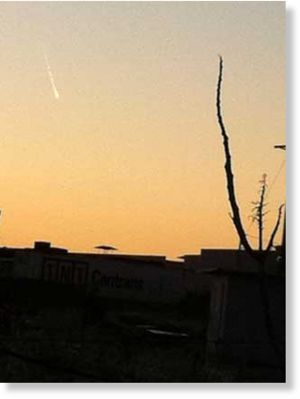
© PerthNow
FALLING STAR: PerthNow reader Robin Scott captured this "falling star'' over Morley early Saturday morning.
FALLING STAR: PerthNow reader Robin Scott captured this "falling star'' over Morley early Saturday morning.
The
mysterious "falling star'' sighted over Perth early Saturday morning
has been identified as a Soyuz rocket body which was scheduled to
re-enter the Earth's atmosphere.
PerthNow reader Robin Scott captured these images of what appeared to be
a "falling star'' early Saturday morning when he was in the Morley area
looking east or south-east.
Bickley Observatory government Astronomer Ralph Martin initially said he
was unsure what the strange lights in the sky were, but said it
appeared to be some kind of man-made object "re-entry''.
Mr Martin did some research and gave PerthNow the answer 24 hours later.
"It was a Soyuz-U Rocket Body that was due to re-enter the earth's
atmosphere at 6.40am WAST, instead it re-entered 1.5 hours (90 minutes)
earlier, which isn't that unusual, off the southern coast of
Australia,'' Mr Martin said.
Mr Scott told PerthNow he was leaving work early Saturday driving towards Tonkin Highway when he saw what he described as a "falling star''.
"I was going home from work leaving Morley driving towards Tonkin Highway,'' Mr Scott explained.
"I saw what looked like a falling star.The star fell from the top of the
sky then suddenly stopped in motion near the bottom of the sky.''
Mr Scott managed to snap off four quick images, capturing the action.
Ralph Martin, astronomer at WA's Bickley Observatory, said there had
been a second reported sighting of something burning up as it entered
the Earth's atmosphere.
"We had another report this morning from a guy in High Wycombe, who was
looking east, who saw something similar at about 5.20am,'' Mr Martin
said.
Mr Martin said it appeared to be a "re-entry'' -- some kind of man-made
object burning fuel as it re-entered the Earth's atmosphere.
He said it could have been a dying rocket, or some kind of space-junk falling to Earth.
He said it was a relatively slow-moving object, which tended to discount the theory that it was a meteor falling to Earth.
Mysterious booms rock North Carolina coast
Mon, 08 Nov 2010 19:54 CST
Associated Press
Associated Press
Wilmington - It's not clear what caused those booms that rattled
south coast last week. But methane escaping from the ocean or even a
small meteorite have been suggested as culprits.
John Huntsman is an associate professor of geology at UNC-Wilmington. He
heard a boom on Friday but isn't sure of the cause. There was a second
Saturday.
It wasn't an earthquake because there was no seismic activity. Military bases reported no aircraft exercises.
Similar booms have been heard along the South Carolina coast in the
past. Suggestions have included methane bubbles being released below the
ocean and breaking the surface.
Huntsman says some scientists have suggested they are caused by tiny meteorites hitting the atmosphere.
Did You See The Fire In The NYC Sky?
Thu, 11 Nov 2010 09:02 CST
CBS New York
CBS New York
Chopper 2 Films Red-Hot Streak Moving Behind Emp. State Bldg
© CBS 2
Chopper 2 HD captured images of a red-hot streak ripping through the NYC sky nearing dusk on Nov. 10, 2010.
Chopper 2 HD captured images of a red-hot streak ripping through the NYC sky nearing dusk on Nov. 10, 2010.
New York - Did you see it? Chopper 2 HD sure did.
It was a bizarre, glowing red-hot streak in the sky - right at sunset
Wednesday - moving briskly behind the Manhattan skyline.
CBS 2 reached out to a top astronomer who looked at the video. He said
it looks beautiful, but that is was like nothing more than what's known
as a "contrail" - condensation from a commercial or military jet.
The aliens, apparently, are not coming.
The sighting came one day after a mysterious condensation trail was spotted off the coast of California. Speculation over the object that caused it ranged from a fired missile to a contrail from a commercial airliner.
Most experts now believe an airplane caused that vapor trail.
What went down over the skies of NYC Wednesday was just the latest in a
series of weird events that have captivated tri-state area residents
over the last few years. Back on Oct. 13, CBS 2 cameras captured objects
in the sky while shooting up above Chelsea at 23rd Street and Eighth
Avenue.
Local media and the NYPD received several calls throughout that afternoon.
However, as CBS 2 cameras showed, the objects appeared to be yellow
balloons, although there was initially no official confirmation from the
NYPD. On the streets below there was a lot of intrigue about the
mystery that was going on up above.
Strange sightings in the sky are not new to our area. Back in January of
2009, odd red, blinking lights could be seen across Morris County,
N.J., and officials thought they had figured out what caused them.
In the end, though, it wasn't exactly a close encounter.
It turns out the lights were part of a hoax. Prosecutors said two men
with too much time on their hands pulled off the trick with five flares,
fishing line and helium balloons.
Comment: Wow! CBS is really going into
disinformation over-drive! The utter ridiculousness, and indeed horror,
of these news reporters blithely dismissing this event as a 'contrail'
beggars belief. This was clearly no more a contrail than the 'missile'
that was seen off the coast of California a few days previously. Note
also that the female presenter momentarily uses her common sense and
hits the nail on the head: "looks like a COMET racing across the
sky...pretty cool!"
The topic of meteorites and the fact that our planet has experienced
cyclic and devastating cataclysms caused by meteorite impacts is
virtually unknown, despite the large amount of scientific evidence
supporting this vitally important area of research.
Over the past few years Sott.net has been documenting the startling
increase in meteorites that have been entering our atmosphere, exploding
in the air and hitting the ground. Does it not occur to anyone that the
frequency of such visitors today has not been witnessed in living
memory?
The human race, and the planet on which it lives, is long overdue for
another round of this cyclical destruction from above, yet those
individuals and institutions supposedly employed to keep us informed are
nonchalantly dismissing the clear evidence that we are running out of
time. The next extinction event is imminent!
Fireball Over Serbia and Macedonia
Sat, 13 Nov 2010 12:28 CST
B92 News
B92 News
Vranje, Belgrade -- Milan Jeličić of the Ruđer Bošković Astronomical
Society says that a bolide was seen in the sky above Serbia last night.
"A
bolide is a luminous meteorite which is more luminous than Venus and is
accompanied by sound effects which are created as it disintegrates," he
explained.
According to him, one could not see anything from the observatory Kalemegdan observatory due to unfavorable weather conditions.
Tanjug news agency correspondent from Vranje reported that a light ball
was seen in the sky last night at 19:32 in several towns in that part of
the country.
The luminous body flew across the sky at great speed and a strong detonation was heard afterward.
The Ruđer Bošković Astronomical Society says that bolides, celestial
bodies often confused with meteorites, fell four times in Serbia so far
and the last time it was near Čačak in 1919.
Jeličić says that there is a possibility that the bolide even fell to the ground.
"A bolide, unlike meteorite which combusts upon entering atmosphere, can
get to the Earth's crust and sky stones which we find on the ground are
actually meteorites," he explained.
Aside from Čačak, meteorites were found near Soko Banja in 1877 and at Mt. Jelica in 1889.
According to Jeličić, a bolide flying through the Earth's atmosphere and
falling to the ground is a normal phenomenon and observing the entire
planet it is not rare at all.
He also stressed that bolides could "enter and exit" the atmosphere without falling to the ground.
Source:Tanjug
Flashback:
Meteor Fireball Explodes Over Netherlands
Tue, 13 Oct 2009 16:30 CDT
DutchDailyNews
DutchDailyNews
A fireball meteor zipped across the Netherlands sky Tuesday evening before exploding in to the North Sea, an expert says.
The Netherlands just escaped a natural disaster from a meteor. Many
Dutch people in the Netherlands witnessed a large "fireball" meteor in
the sky. In the north people heard a bang and saw flashes. Also on
Twitter people reported on the phenomenon.
The Groningen astronomical Theo Jurriens confirmed that this was a very bright meteor and at one point burst into three pieces.
About one hundred reports
have been received from people who have seen the fireball. From the
north of the Netherlands there are reports of people who heard rumblings
when the meteor passed by and buildings were shaking.
Several pictures of the fireball meteor have been posted on the internet.
Update:
The meteor exploded over northern Netherlands and the North Sea and caused an explosion that made shock waves.
The blast may have been caused by the meteor or the explosion because it
was faster than sound with a speed of over 1200 kilometer per hour.
KNMI does not know which of the two is the cause, but measurements seem
to indicate that it is an explosion, because signals are recorded
earlier in the north than in De Bilt Netherlands.
Observations indicate that the orbit of the meteor came from south to
north. Further research is being made about the precise path of the
meteor.
The seismometers of the KNMI, recorded the shock waves around 19:00. The
institute was mainly receiving reports from Rotterdam and Groningen. In
Groningen, the shock wave generated vibrations on the ground.
East Coast USA Meteor Sightings 2NOV2010
Wed, 03 Nov 2010 07:27 CDT
LunarMeteoriteHunter
Latest Worldwide Meteor/Meteorite News
Tokyo, Japan - posted from reader/observers within 10 minutes of event at about 7:20pm EDT .
Anyone with video, still photos or cell phone captures please contact
me. Readers, emergency responders, police, or media persons reading
this please try to acquire video; this is critical for locating any
potential meteorites from this event.
AMS Fireball Report Form, Have you seen an extremely bright meteor?
Share your sighting with others across the globe by filling out our
fireball report form.
2NOV2010
"Driving home from work this evening, around 7:20 pm ; Initially I
thought it was the vapor trial from a jet as it caught my attention (we
live south of Logan Airport) Then I could see it looked like a ball of
fire with a comet-like tail behind it, but was moving much slower and
was much bigger than a shooting star. I was worried that it might be a
jet on fire and crashing because I could see it breaking up and a shower
of debris behind it and it was coming in at an angle like a jet. It was
traveling South-East to North-West - and I was in North Quincy MA
heading east at the time. Very strange; I've never seen anything like
it." -- Amy B., Quincy, MA (contact info)
2NOV2010
"I just saw the biggest meteor I have ever seen in my life tonight.
It was around 7:15 pm and I was in East Weymouth. At first it appeared
to be a low flying plane on fire but it was actually a large white ball
with a long tail behind it. It went from West to East. It appeared to
be heading towards Boston from the South Shore and was traveling
horizontally across the sky. It lasted about 3-4 seconds and eventually
exploded with red pieces falling towards the Earth. It would seem that
somewhere in North Weymouth, MA or Hingham, MA there may be pieces of a
meteor lying on the ground!" -- SJDoran (contact info)
2NOV2010
"Got out with the wife in Belmont, MA to vote, and we saw a very
slow moving bright light going from what looked to be SE to NW, or maybe
E to W. This was between 7:15 and 7:20. We both got out of the car,
gasping at the sky, and as someone who has seen plenty of shooting stars
and fast moving objects, this was moving far slower than anything I'd
ever seen. It also looked much lower, and appeared to have several
different "jets" of light coming off it, so I guessed that it may have
been breaking up. We lost it through the trees, as we were both trying
desperately to get our cell phone cameras out... but alas, even though
it was slow, we were even slower."
-- Brian S., Belmont MA (contact info)
2NOV2010
"THANK YOU!!! I saw a very large "ball of fire" with an even longer
tail behind it - going from East to West over Hampstead, NH at 7:18PM
tonight. It only lasted a couple of seconds, but it was really bright -
and then it was gone. I asked friends, but nobody else had seen it - so I
started searching online ... and here it is" ! -- Elaine
2NOV2010
"I just saw a very large Meteorite shoot across the sky here in
Massachusetts, it was traveling east to west, seemed to be very low to
the ground and was breaking up into pieces as it traveled across the
sky, It had a very long trail of "flames" and as the pieces broke off
they also had trails behind them. I have seen many smaller Meteorites
while fishing at night on cape cod but nothing as large and low to the
ground like this." -- Scott M. (contact info)
2NOV2010
"I just saw a fireball at approximately 7:30pm from Warwick, RI. It
was travelling from east to west and lasted about two seconds. At first
I thought it was a plane (we are close to the airport), but then
noticed it had the distinctive round mass of a fireball. It was bluish
green and so amazing. I used to teach astronomy so it was especially
exciting for me. My husband was surprised but not nearly as excited as
me!" -- Alicia (contact info)
2NOV2010
"I also observed this event while using my telescope last night
viewing Andromeda. About 4-5 degrees off of the horizon beginning in
the east and transiting out of view to the north. Bright white in
appearance, with fragments falling off. I didn't witness the beginning
or end of the event but the time frame reported by others sounds
accurate. I began viewing Jupiter around 7pm and was just moving on to
Nebula when I witnessed the event. Reminded me of the video of the
shuttle break-up a few years ago. I thought it might be a satellite
re-entering." .....Mike in Hudson, NH (contact info)
2NOV2010
"Harvey Leonard (highly respected Boston MA area meteorologist) said
that this might be the end of the Orionids or the beginning of the
Leonids. I probably saw the same show that others report below. In
Gloucester/Rockport MA at 7:15 p.m., with a very clear dark sky, we saw a
very bright, very low fireball (but colored green, no red - is this
weird?) with a wide, long tail of white sparklers moving from southeast
to northwest. It appeared to be breaking up quickly" -- Jane Seigel
(Contact info)
2NOV2010
DATE: 02 NOV, 2010 @ 19h 17m EDT
PLACE: Elizabeth Brown Elementary School, 29 Gardners Neck Rd. Swansea, MA, USA
SKY: Cloudless; chilly
SIGHTING DETAILS: Initially about 0 degrees azi. @ about 15 degrees alt.
Finally about 10 degrees azi @ about 10 degrees alt.
Duration about 3~4 sec.
General Bright, details visible
in the tail, straight track sloping down t the left; passing over the
three arc-stars in handle of Big Dipper" -- LON CARACAPPA (contact info)
2NOV2010
"I was at Shaws in Salem, NH last night around 7:30 when I saw
something in the sky. At first I thought it was a plane on fire. Then I
thought it was silent fireworks but it was going horizontal. I was in
such awe not knowing what I saw that I didn't even think to take a
picture with my phone. I was traveling so slow. It was a very sureal
moment and I wonder if I will ever see another one in my lifetime. I
would love to see a video if anyone else captured activity last night."
-- Maryellen (contact info)
2NOV2010
"We saw a spectacular fire ball coming from the east south east
passing between Cassiopeia and Perseus in Cumberland, Maine, about 7:30p
on November 2nd. It seemed to last for about 4 to 5 seconds, was slow
moving, yellowish wide streak turning reddish as it broke into several
pieces just at its end. Definitely a life time best for me." -- Bill
Rixon of Freeport, Miane (contact info)
2NOV2010
"I also saw this one and filed a report with amsmeteors.org --
though it hasn't shown up yet.-- 1917 EDT, Westford, northest to north
travel. Very slow -- maybe 3 degrees per second. Exploded into fragments
at the end. Significant trail (maybe 5 degrees)" - - Philip (contact
info)
2NOV2010
"In Stoneham I saw a large white object with a rounded front end and
a tail at about 7:20 last night. It appeared to have scattered objects
trailing behind it but everything was white (no red). It went from
east to west with a slight turn to the south. It streaked right over my
neighbors house and seemed so low I thought it might touch the roof.
It appeared to be very large so I immediately ruled-out a shooting star.
I thought it might be a plane but the shape was so perfectly round in
the front and there was such a perfect tail behind that I thought it
could only be celestial. By the time I ran to the back yard it was not
in sight.
Thank you for your blog. I have an understanding of what I saw in Stoneham, Mass on Nov. 2"
Marilyn M (contact info)
2NOV2010
"On the way home at 7:19pm this evening I saw what I thought was an
awfully low-flying airplane. It's flight path was parallel to snow hill
rd between kelton rd and the gardner farm.
(MOVING SLOWLY EAST TO WEST) as it came over my windshield it
began to split into a (long) trail of large shooting stars....the car
behind saw it too-did you?
I was rushing, so long trail of shooting stars does not describe it
well. Someone else's description of "breaking up describes it better - a
big chunk leading the way and smaller pieces, trailing. It moved at
the speed of a jet flying low, but went out when it was just past
overhead - long before reaching the horizon..." Jennifer (contact info)
2NOV2010
"I observed a the most dramatic fireball of my life for about 4 sec
transiting my NE-facing window (~16 miles NW of Boston) about 3-4
degrees above the horizon, it was yellow with a sizable fireball and
relatively short tail, shedding pieces. I was a private pilot, and know
the flight pattern of the nearby airport well, so I can say that this
was comparable in apparent size to a Cessna 150-series at ~2000 ft, 1
miles out. In actual size, I believe the technical term would be
"humongous"""I forgot to note: my sighting was just before 7:20 EDT."
-- Anonymous - sign of the times? (no contact info)
2NOV2010
"On the night of Nov. 2, 2010, my boyfriend and his cousin witnessed
this super fast (approx. 800 mph) fireball with a burning glow to it as
it sped over them, kinda close....after reading about Hartley's Comet
2, I think it had to be that....he was so excited about it, he called
the police right away and they confirmed it with the FAA that 10 other
people saw it too. They were heading up north on rt. 22 in Amenia, NY
near Renneys at around 7:15pm....I was excited too for them and only
wished I was there also experiencing it for myself.....my boyfriend is
very cosmic...seems that he has witnessed extraordinary
objects/sightings/UFOs since living up in Amenia. We both witnessed
UFOs on the night of July 3 and July 5, 2010 also in Amenia, NY. We are
DEFINITELY NOT ALONE." -- Blackwhiskers(contact info)
Caught On Camera: Bright Light Streaks Across Seattle Sky
Wed, 03 Nov 2010 10:56 CDT
KIROTV.com.
KIROTV.com.
Seattle -- Did you see the unusual light show?
KIRO 7 Eyewitness News Reporter Michelle Millman and engineer Dan Crouch
both saw flaming debris streak across the sky at about 3:20 Wednesday
morning.
A surveillance camera at Honda of Kirkland captured the streak of light.
The dealership is in the heart of Rose Hill in Kirkland on NE 85th
Street.
Sliedeshow: Bright Flash Caught On Camera
Michelle saw the light streak while driving down Interstate 405 south, she said.
Dan saw it just after getting onto Interstate 5 from State Route 520, he said. He saw a big, orange flash before it disappeared
The light show could be part of the Taurids meteor shower. The FAA told KIRO 7 it had no information about the event.
US: Tucson scientist reveals new dangers of asteroid impact
Fri, 05 Nov 2010 15:31 CDT
KVOA
KVOA
New research by a Tucson scientist reveals shocking details about
asteroids and our planet. The study shows certain asteroids could be
more destructive than we ever thought.
Elisabetta Pierazzo, a senior scientist at the Planetary Science
Institute, studied asteroids ranging from 500 meters to one kilometer.
Unlike the one that killed the dinosaurs, these asteroids would not
cause mass extinction.
"There is a chance that it could be a large enough impact to destabilize
current civilization. And there's never been a quantification of what
does that mean," Pierazzo said.
Pierazzo's study shows what might happen if one of these medium size asteroids landed in the ocean. She created simulations, looked at the data and found that kind of impact would have world-wide repercussions.
"You're going to throw a lot of water vapor and, with that, you're going
to throw a lot of chloride and bromide into the upper atmosphere,"
Pierazzo said.
Those chemicals could destroy at least 60 percent of the ozone layer all
over the world. People and plants would have little natural protection
from harmful ultraviolet rays, forcing us to stay inside or wear
sunscreen and hats all the time. However, plants and fish would be stuck
unprotected in the sun.
"We are going to have less food to eat and it's going to be a major problem for this world," Pierazzo said.
Edward
Beshore, Senior Staff Scientist at the Lunar and Planetary Laboratory
and Principle Investigator for the Catalina Sky Survey, spends his days
looking for asteroids.
"Most of the objects we find are about 100 to 200 meters across," Beshore said.
As for the asteroids from Pierazzo's study, Beshore says they spot about
50 a year. A small number of them come within five million miles of the
earth's orbit. Those can be unpredictable.
"If they cross the orbit of the earth, they are potentially hazardous
asteroids that we really need to keep our eye on," Beshore said.
In all, there are a couple hundred of those potentially hazardous,
medium sized (500m to 1 km) asteroids out there. On average, asteroids
that size hit the earth about every 25,000 to one million years.
US: More Fireball Sightings 7NOV2010
Mon, 08 Nov 2010 08:23 CST
LunarMeteoriteHunter
Latest Worldwide Meteor/Meteorite News
*If you wish to leave a comment please do; comments with name, time,
location and information about what you saw are important. Please leave
your contact info; I will not post your contact info.
email drtanuki@gmail.com Thank YOU!
To officially register your meteor report please go here.
Monroe, Ohio 8NOV2010
"I cannot believe the Bolide that I saw this morning at 4:20 or 4:25AM, I
was outside sitting on my daughters deck drinking coffee in the
cold,(waiting to go hunting) when looking south. The biggest, brightest
"slow moving" meteor I have ever seen came out of the western sky and
headed south east. I was in Monroe Ohio, which is between Cincinnati and
Dayton. It came in very low in the sky! with sparks trailing. As it
was 10 to 15 degrees above the Horizon there was a Very Bright Flash
that lit up the sky and it looked like the front or bottom blew out as
it fragmented.
At this Time it entered the city sky light of west Chester, Ohio which
is directly south of Monroe, and I lost sight of it completely. This is
the 1st one like this I have ever seen and will never forget it. It was
far enough away that I heard no sound. There must be alot people
traveling south on I-75 and I-71 who saw this, so we should hear more
reports today.
Also, I now see why some people think there seeing a jet on fire, It was
moving at the speed you would think a jet would. MY 1ST, WAY TOO COOL!"
- DAVE M. (contact info)
Georgia 7NOV2010 (Georgia/ south Carolina border)
"I saw a white fireball in the sky on Sun Nov 8, 2010. It was
approximately 7:35 pm eastern standard time. The light was at the
Georgia/ south Carolina border. I was traveling south on I-95, at first
I thought it was a plane crashing, but there was no explosion. I guess
it was a meteor. It lasted only about 10 seconds, It was a little scary
though." --Tzana (contact info on file)
Sault Ste Marie 7NOV2010
Guest513 (guest): "In Sault Ste Marie,Ontario I saw a bright object
moving Quickly across the eastern sky at 6:40 PM,EST on Nov 7, 2010. It
was travelling in a north to south direction." (no name or contact info)
Stevens Point, WI 7NOV2010
Guest938 (guest): "i saw a meteorite about 7 pm central Sunday Nov 7
time right outside of Stevens point WI heading what looked like north to
south west" (no name or contact info)
Phoenix, AZ 7NOV2010
Guest8 (guest): "In Phoenix AZ my mom was sitting on her patio at 6:30
pm. She came running in the apartment and said she just saw the largest
light fly across the sky. She said it came from the southwest and moved
toward the northeast. It was so large and falling so fast she thought a
plane was crashing. After it fell behind the trees, she was expecting to
hear an explosion as she really thought it was a plane crashing. It is
interesting there is so many sightings of this at around the same time
from all over, from TN 2 AZ" (no name or contact info)
Georgia, USA 7NOV2010
"Anonymous said...
MY FRIEND AND ALSO SAW THIS IT LOOKED LIKE A FALLING PLANE FROM THE SKY
WE HAD NEVER SAW A METEOR BEFORE SO WE THOUGHT IT WAS A PLANE, IT SHOT
DOWNWARD VERY FAST. IT WAS BETWEEN 6:30& 7P.M.GEORGIA TIME..." (no
contact info or name)
LaVergne, TN 7NOV2010
"My wife texted me at work and said she saw either a meteor or a plane
crash while plugging in our Christmas lights also and she said she saw a
ball of fire fall from the sky from about northwest to east at about
7:30 pm central time today (November 7, 2010). So I was on google for
about 2 hours before I found your post. We live in LaVergne, TN about 15
minutes south of Nashville." -- Douglas (contact info)
Knoxville, TN 7NOV2010
hullaballo: Earlier today, I heard a "pop" like a distant gun shot. Was
not in a part of the house where I could see outside.Moments later my
wife asked if I saw the bright flash and heard the pop. She asked me if
it could have been a meteor. This occured in Knoxville, TN. Any other
reports of activity????
Missiauga, Ontario , Canada 7NOV2010
Guest314 (guest): we saw a meteor tonight, Mississauga, Ontario , Canada in the northern sky at around 6:30 pm
Kingman AZ Meteor? 7NOV2010
"I live in Kingman, AZ. I went outside to look at my Husband's
Christmas lights he was turning them on for the full impact. I looked
up in the sky and saw something like a falling star or meteor it was
moving from the north falling down towards the east it was the largest
thing I have seen and it seemed pretty slow although it was moving
pretty fast. It was 11/07/10 at about 6:30 p.m. Sunday evening. It
wasn't totally dark so it was pretty easy to see it."
Marie (contact info)
Comet Ikeya-Murakami Outburst
Tue, 09 Nov 2010 21:58 CST
Space Weather
Space Weather
Comet Ikeya-Murakami (C/2010 V1) is definitely undergoing an outburst
event. Italian astronomers Ernesto Guido and Giovanni Sostero assembled
the following animation from images they obtained between Nov. 4th and
Nov 9th:
See the animated image here.
The sequence clearly shows an explosion in progress. "Only Nov. 7th is
missing," they say, "because of rare cloudy skies over New Mexico, where
the remotely-controlled telescope we used is located."
Another New Mexico observer, Leonid Elenin, estimates the size of
comet's expanding atmosphere as 4x6 arcminutes. "There is also some evidence of two symmetrical jets emerging from the nucleus of the comet," he says.
The behavior of this comet reminds many onlookers of exploding Comet Holmes
in 2007. Researchers believe Holmes exploded when an icy cavern in the
comet's nucleus collapsed. Perhaps something similar has happened to
Comet Ikeya-Murakami. The icy visitor from the outer solar system made
its closest approach to the Sun in late October, so it has just received
a dose of solar heating that could trigger such an event.
Amateur astronomers are encouraged to monitor developments. Various
reports put the brightness of the comet between 7th and 9th magnitude,
invisible to the naked eye but an easy target for telescopes such as the
Comet Hunter.
It's easy to find, too, little more than a degree from Saturn in the
eastern sky before dawn. Set your alarm and happy hunting! [Sky maps: Nov. 9, 10, 11] [3D orbit] [ephemeris]
More Images: from Joseph Brimacombe using a robotic telescope in New Mexico (Nov.8); from Gil Esquerdo of Whipple Observatory, Mt. Hopkins, Arizona (Nov. 8); from Tenho Tuomi of Lucky Lake, SK, Canada (Nov. 7); from Gregg Ruppel of Ellisville, Missouri (Nov. 7); from Feys Filip of Crete, Greece (Nov. 6); from Gregg Ruppel of Ellisville, Missouri (Nov. 6); from Gregg Ruppel of Ellisville, Missouri (Nov. 5); from Luca Buzzi of the G.V. Schiaparelli Astronomical Observatory in Varese, Italy (Nov. 4);
Newly Discovered Fast-Changing Comet Ikeya-Murakami
Mon, 08 Nov 2010 19:21 CST
Denise Chow
SPACE.com

© Leonid Elenin
Comet
Ikeya-Murakami (C/2010 V1) appears to brightening, signifying it could
be in the middle of an outburst. Furthermore, the comet's gaseous head
or "coma" bears a striking resemblance to that of Comet Holmes, which
experienced a dramatic brightening and explosion in 2007.
Comet
Ikeya-Murakami (C/2010 V1) appears to brightening, signifying it could
be in the middle of an outburst. Furthermore, the comet's gaseous head
or "coma" bears a striking resemblance to that of Comet Holmes, which
experienced a dramatic brightening and explosion in 2007.
A
newly discovered comet that has caught the attention of skywatchers
around the world appears to be undergoing some dynamic changes.
The comet, called Ikeya-Murakami (C/2010 V1), was first detected last
week by amateur astronomers in Japan, but several other skywatchers have
since been watching the icy wanderer's changing appearance over the
last few days.
Russian astronomer Leonid Elenin, of Moscow, used the remotely operated
ISON-NM telescope in New Mexico to observe the new Comet Ikeya-Murakami
over the weekend.
"After the discovery, C/2010 V1 looked like a bright fuzzy ball, without
details," Elenin told SPACE.com in an e-mail. "But after a few days, I
was discouraged - [this] comet is rapidly changing."
The comet appears to brightening, signifying it could be in the middle
of an outburst, according to Spaceweather.com. While the comet cannot be
seen with the unaided eye, it should be easily detectable with backyard
telescopes, the website added. Typically, however, finding a comet with
a telescope can be tricky for those who are not familiar with sky
charts and the night sky.
I was excited when I knew about this bright amateur discovery. I
was right in my observatory, doing my routine minor planets follow-up,
and I hoped the sky remained clear to catch the comet a few hours
later," Buzzi told SPACE.com. "It's good that in this modern era,
dominates by the big surveys, there is space left also for amateurs
discoveries.
US: Fireball in Maryland & Pennsylvania, Nov 12, 2010
Sat, 13 Nov 2010 13:04 CST
LunarMeteoriteHunter
Latest Worldwide Meteor/Meteorite News
I just got a report from a neighbor in Freeland, Maryland who
witnessed what he called a massive fireball. It started in the south
from his position, went over head and ended in the north. He said it
left behind a brilliant white streak of light in the sky that remained
for a few seconds after the fireball had past. See: Astro Mike for more. If you saw this event please fill out the AMS Meteor Sighting Report Form (here).
Other Sightings:
Milford DE no time given 11/12/2010
Guest14 (guest): I saw the meteor reported above on the night of
11/12/2010 from Milford DE on the DE shore. It was the largest and most
brilliant I have ever seen, with a long sparkly tail and lasting in my
view for a good 7 seconds.
Washington D.C,at 8:30 PM local time 12NOV2010
Tom from Lanham, MD (Guest157):Last night just east of Washington
D.C,at 8:30 PM local time a fireball was visible to the north that
proceeded slowly across the sky on a northward heading. It lasted about
four or five seconds and apparently disappeared while still at a high
altitude.I may have been a larger object that skipped into and out of
the atmospere. It did not appear to explode or fragment apart.... (no
contact info)
Fennville Michigan USA ~11:15 and 11:30. EST 12NOV2010
Dustin Rea writes, (Guest954): In Fennville Michigan USA Just saw
orange/red fireball shooting southwest going down like it was setting.
very cool... Looking Southwest ... So were in Fennville Michigan, my
wife just went out for a smoke and she said "looking southwest She see's
just above the horizon a bright pinkish/orange light with a reflection
off the end of it that sat in space and fizzeled away from her sight
like it was moving down. She asked me if the moon sets like the sun
because thats what it look like.
'Giant meteor' seen over Scotland
Mon, 15 Nov 2010 12:02 CST
BBC
BBC
Witnesses across Scotland have described seeing a "giant meteor" streaking across the sky.
The meteor is reported to have broken into a number of pieces and it left bright streaks of light in the sky at about 0540 GMT.
It was spotted in Glasgow, Scotlandwell and Durness.
Douglas Thornton, from Scotlandwell, said: "It was an off-white light with a massive tail behind it... A phenomenal sight."
It is thought the meteor was part of the annual Taurids shower, which lasts from October into November.
Mr Thornton was on his way to Edinburgh Airport when he spotted the meteor while driving.
He told the BBC Scotland News website: "You can see shooting stars every
night up where we are, but this was the most enormous streak of light.
Enough to back-light the clouds and make them flicker.
"It was moving at an enormous speed. I first saw it in the direction of
Auchterarder and by the time I lost sight of it about two seconds later,
it was around the Dundee area."
David Wood, said he had just left Durness, on the north coast of
Scotland and was heading south towards Kinlochberbie when he saw a
"bright green, fairly jagged looking, object in the sky".
He said: "It had a very short, but very bright yellow and red trail
behind it. It could have only been a few hundred meters above the
ground.
"After my initial view I slowed the car and it broke in two. The larger
piece eventually broke up into four smaller pieces which then dissipated
into the darkness."
The meteor was also seen about 270 miles (435km) to the south, above Glasgow.
Jay Joyce described it as "around the size of a fridge" with a very long tail.
He added: "It burned for ages and then dispersed near to BBC centre on the Clyde.
"It exploded and went into three pieces which then burned out, but the main body of it was very big."
A similar meteor was seen last week by astronomy expert John Braithwaite
while travelling back from giving a presentation to schoolchildren in
Dundee - about meteorites.
Mr Braithwaite, who builds astronomical telescopes, said the meteor he
spotted with his friend Jared Earle in the early hours of 12 November
had been "80 to 90 times brighter" than anything else in the sky.
'Grain of sand'
"There was a very pronounced and bright head to the meteor, which was
deep blue at the centre with a green fringe around it," he said.
"They're both probably part of a meteor shower which appears from between mid-October and November every year."
Dr Martin Hendry, from Glasgow University's astronomy department, said:
"It certainly sounds possible that it's a meteor of some sort.
"From the descriptions of it being very bright and breaking up, it may have been somewhat larger than normal meteors.
"But even a grain of sand can produce the 'shooting stars' we see - very
small objects indeed. It would not need to be that much bigger."
Dr Hendry, a fellow with the Science and Technology Facilities Council,
said the different colours could have been a reflection of the different
chemical compounds in the meteor.
He said it was possible the meteor reached earth, but that it would be
difficult to pinpoint exactly where without precise compass bearings
from the people who saw the object.
New Discovered Sundiving Comet
Sat, 13 Nov 2010 23:06 CST
SpaceWeather.com
SpaceWeather.com
A newly-discovered comet is diving toward the sun, and it will probably not survive the encounter. Click here to view a movie of the death plunge.
Japanese comet hunter Masanori Uchina first noticed the sundiver in coronagraph
images from the Solar and Heliospheric Observatory (SOHO) on Nov. 13th.
At the time it was a dim and distant speck, but now the comet is
brightening rapidly as it approaches the hot sun. The bright glare of
the sun hides these events from human eyes, but not from certain
spacecraft: Join SOHO for a ringside seat.
Leonid Meteor Shower
Tue, 16 Nov 2010 06:56 CST
spaceweather.com
The
annual Leonid meteor shower peaks this year on Nov. 17th when Earth
passes through a thicket of debris from Comet Tempel-Tuttle. Earth is
expected to miss the densest swarms of comet dust, making this an
off-year for Leonids with a maximum of only 20 meteors per hour. The
best time to look is during the dark hours before sunrise on Wednesday.
Bonus:
Turn up the volume and play this movie
of an early Leonid recorded on Nov. 14th by amateur astronomer Thomas
Ashcraft in New Mexico. The soundtrack is a forward scatter meteor
echo--that is, a radio signal from a distant TV transmitter bouncing off
the meteor's ionized trail. See? Even one Leonid can be enough.
Witnesses across Scotland have described seeing a "giant meteor" streaking across the sky.
The meteor is reported to have broken into a number of pieces and it left bright streaks of light in the sky at about 0540 GMT.
It was spotted in Glasgow, Scotlandwell and Durness.
Douglas Thornton, from Scotlandwell, said: "It was an off-white light with a massive tail behind it... A phenomenal sight."
It is thought the meteor was part of the annual Taurids shower, which lasts from October into November.
Mr Thornton was on his way to Edinburgh Airport when he spotted the meteor while driving.
He told the BBC Scotland News website: "You can see shooting stars every
night up where we are, but this was the most enormous streak of light.
Enough to back-light the clouds and make them flicker.
"It was moving at an enormous speed. I first saw it in the direction of
Auchterarder and by the time I lost sight of it about two seconds later,
it was around the Dundee area."
David Wood, said he had just left Durness, on the north coast of
Scotland and was heading south towards Kinlochberbie when he saw a
"bright green, fairly jagged looking, object in the sky".
He said: "It had a very short, but very bright yellow and red trail
behind it. It could have only been a few hundred meters above the
ground.
"After my initial view I slowed the car and it broke in two. The larger
piece eventually broke up into four smaller pieces which then dissipated
into the darkness."
The meteor was also seen about 270 miles (435km) to the south, above Glasgow.
Jay Joyce described it as "around the size of a fridge" with a very long tail.
He added: "It burned for ages and then dispersed near to BBC centre on the Clyde.
"It exploded and went into three pieces which then burned out, but the main body of it was very big."
A similar meteor was seen last week by astronomy expert John Braithwaite
while travelling back from giving a presentation to schoolchildren in
Dundee - about meteorites.
Mr Braithwaite, who builds astronomical telescopes, said the meteor he
spotted with his friend Jared Earle in the early hours of 12 November
had been "80 to 90 times brighter" than anything else in the sky.
'Grain of sand'
"There was a very pronounced and bright head to the meteor, which was
deep blue at the centre with a green fringe around it," he said.
"They're both probably part of a meteor shower which appears from between mid-October and November every year."
Dr Martin Hendry, from Glasgow University's astronomy department, said:
"It certainly sounds possible that it's a meteor of some sort.
"From the descriptions of it being very bright and breaking up, it may have been somewhat larger than normal meteors.
"But even a grain of sand can produce the 'shooting stars' we see - very
small objects indeed. It would not need to be that much bigger."
Dr Hendry, a fellow with the Science and Technology Facilities Council,
said the different colours could have been a reflection of the different
chemical compounds in the meteor.
He said it was possible the meteor reached earth, but that it would be
difficult to pinpoint exactly where without precise compass bearings
from the people who saw the object.
Meteors visible across Scottish skies
Leonids meteor shower reaches its peak amid reports of bright objects hurtling through the skies at night.
Scots have been getting the chance to spot meteors in the night sky,
with a number of reports of bright objects passing over the country
overnight.
There were reports from Glasgow, Perthshire and Sutherland of a bright
light crossing the sky in the early hours of Monday morning which
appeared to break up into smaller streaks of light.
The sightings come as the annual Leonids meteor shower reaches its peak.
The annual phenomenon is expected to be at its most intense on November
17 and 18, although meteors can frequently be seen several days before
and after.
The Leonids are one of the most spectacular of the annual meteor
showers, and can produce around 40 meteors an hour, which seem to
originate from the constellation of Leo.
STV weather presenter Sean Batty said: "We see several showers
throughout the year as the earth passes through fragments of ice and
dust left in the wake of passing comets. As these pieces of ice, dust
and rock hit our atmosphere most are burned up although one or two can
make it to the ground."
In August, the annual Perseid Meteor Shower reached its peak, with
Scotland proving one of the best places to watch the skies, an
early-setting moon meant that the traces of faint meteors crossing the
sky could be seen clearly.
Sean Batty said: "The best places to see it this evening will be across
central and southern areas of Scotland before cloud moves in later
tonight. In the north there will be quite a bit of cloud this evening
although this should disperse into the early hours.
"The Western Isles should have a good view of it."
He added: "The meteors will be more visible in areas far from
streetlight and other artificial sources of illumination, so areas of
the country away from towns and cities may have an advantage."
The best time to see any possible meteors will be in the early hours of the morning.
Bright object 'about the size of a mini' lit up heavens above the Highlands
A very bright UFO flashing through the night sky was seen by several
people from the Highlands right across to Aberdeen-shire yesterday.
Pest controller Edward Cumming was walking his dog at North Kessock on
the Black Isle around 5.45am when he saw the bright object - thought
to be a meteor - flash in his direction from the Clachnaharry area of
Inverness.
Mr Cumming, of Ferry Brae, said: "It was hard to say what size the
meteor was, but it seemed about the size of a football. It was visible
for a few seconds flashing over Clachnaharry towards the Black Isle. It
was fascinating to see, but it was also a bit scary. It then broke up
and disappeared in a dull maroon red colour. I am no astronomer but I
like to look up at the stars."
Mr Cumming was so impressed he then drove to Tesco at Inverness where
his wife Hazel works to ask if she had seen the meteor. She hadn't but
another man who worked there had.
Quantity surveyor David Milne, who was travelling to his work
with Miller Plant Ltd at North Lurg, Midmar, near Inverurie, also saw
the UFO and contacted the Press and Journal to describe what he saw.
He said: "I was travelling westwards when, on the east side of Echt, at
5.42am, I noticed the comet or meteor or similar travelling at speed
from the south going north.
"I slowed down and watched it for about eight seconds before it
disappeared from view. I understand that mention was made of it on Radio
2 later this morning. I reported the sighting to the Meteorological
Office, the Royal Astronomical Society and the Royal Observatory in
Edinburgh."
Another early riser who say the bright light in the sky was Christina Palmer of Carnyx, Aultvaich, Beauly.
She said: "I was walking my dog at about 5am on the hill near my home
and I looked up to the sky to look at Orion, which was low.
"Suddenly from behind me and on the ridge of the hill there appeared a huge white object about the size of a Mini car.
"It was travelling at a fast speed and glowed with a brilliant blue tip
at the front. It went in the direction of Cromarty and exploded into
thousands of pieces .
"If it had not exploded I would have believed I had seen a UFO."
More Booms Reported Rattling Brunswick County
Wed, 17 Nov 2010 11:41 CST
Star News Online
Brunswick County residents in Bolivia, Oak Island, Holden Beach and
Southport areas reported a series of mysterious booms and rattles
Wednesday morning.
No one seems to have any idea what could be causing the loud noises, but
speculation has ranged from the continental shelf shifting and
earthquakes to military exercises and Seneca Guns, the unexplained
phenomenon that sounds like rolling thunder or distant cannon fire.
Similar noises raised suspicions earlier this month when booms
shook the ground across Southeastern North Carolina. No one knew what to
attribute those sounds to either.
Another Doomed Comet
Thu, 18 Nov 2010 11:21 CST
Space Weather
For the second time in less than a week, a comet is diving toward the
sun. Polish comet hunter Michal Kusiak found it yesterday in coronagraph images from the Solar and Heliospheric Observatory:
Click here for an UPDATED movie
It's no coincidence that this comet is following the same path as its
predecessor on Nov. 14th. They are both fragments of a single giant
comet that broke apart about 2000 years ago. Astronomers call them
"Kruetz sungrazers" after the 19th century German researcher, Heinrich
Kreutz, who studied them in detail.
"November is one of the best months to discover Kreutz comets," notes
Kusiak. "It's because the field of view of the SOHO coronagraph covers a
larger-than-usual portion of the Kreutz track. December, May, and June
are good, too."
With SOHO staring at just the right patch of sky, more sungrazers are
probably in the offing. First, however, this one has a date with
destiny, and it probably won't survive. Solar heating is expected to
obliterate the icy sundiver later today or tomorrow. Stay tuned for
movies of the death plunge.
Comet Snowstorm Engulfs Hartley 2
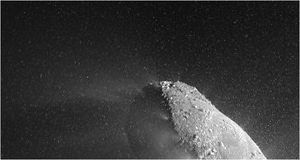
© Deep Impact, NASA
This
contrast-enhanced image obtained during Deep Impact's Nov. 4th flyby of
Comet Hartley 2 reveals a cloud of icy particles surrounding the
comet's active nucleus.
This
contrast-enhanced image obtained during Deep Impact's Nov. 4th flyby of
Comet Hartley 2 reveals a cloud of icy particles surrounding the
comet's active nucleus.
NASA has just issued a travel
advisory for spacecraft: Watch out for Comet Hartley 2, it is
experiencing a significant winter snowstorm.
Deep Impact photographed the unexpected tempest when it flew past the
comet's nucleus on Nov. 4th at a distance of only 700 km (435 miles). At
first, researchers only noticed the comet's hyperactive jets. The icy
nucleus is studded with them, flamboyantly spewing carbon dioxide from
dozens of sites. A closer look revealed an even greater marvel, however.
The space around the comet's core is glistening with chunks of ice and
snow, some of them possibly as large as a basketball.
"We've never seen anything like this before," says University of
Maryland professor Mike A'Hearn, principal investigator of Deep Impact's
EPOXI mission. "It really took us by surprise."
Before the flyby of Hartley 2, international spacecraft visited four
other comet cores - Halley, Borrelly, Wild 2, and Tempel 1. None was
surrounded by "comet snow." Tempel 1 is particularly telling because
Deep Impact itself performed the flyby. The very same high resolution,
high dynamic range cameras that recorded snow-chunks swirling around
Hartley 2 did not detect anything similar around Tempel 1.
"This is a genuinely new phenomenon," says science team member Jessica
Sunshine of the University of Maryland. "Comet Hartley 2 is not like the
other comets we've visited."
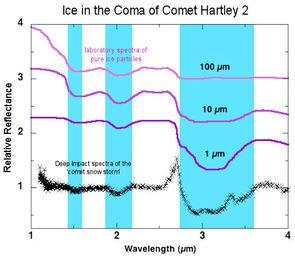
© NASA
This
plot compares the infrared spectra of particles surrounding Comet
Hartley 2 (black crosses) to spectra of pure water ice grains in the
laboratory (purple lines). Micron-sized grains provide the best match.
What it means: Hartley 2's snowballs are made of small bits of H20.
This
plot compares the infrared spectra of particles surrounding Comet
Hartley 2 (black crosses) to spectra of pure water ice grains in the
laboratory (purple lines). Micron-sized grains provide the best match.
What it means: Hartley 2's snowballs are made of small bits of H20.
The
'snowstorm' occupies a roughly-spherical volume centered on Hartley 2's
spinning nucleus. The dumbbell-shaped nucleus, measuring only 2 km from
end to end, is tiny compared to the surrounding swarm. "The ice cloud
is a few tens of kilometers wide--and possibly much larger than that,"
says A'Hearn. "We still don't know for sure how big it is."
Data collected by Deep Impact's onboard infrared spectrometer show
without a doubt that the particles are made of frozen H2O, i.e., ice.
Chunks consist of micron-sized ice grains loosely stuck together in
clumps a few centimeters to a few tens of centimeters wide.
"If you held one in your hand you could easily crush it," says Sunshine.
"These comet snowballs are very fragile, similar in density and
fluffiness to high-mountain snow on Earth."
Even a fluffy snowball can cause problems, however, if it hits you at 12
km/s (27,000 mph). That's how fast the Deep Impact probe was screaming
past the comet's nucleus. An impact with one of Hartley 2's icy chunks
could have damaged the spacecraft and sent it tumbling, unable to point
antennas toward Earth to transmit data or ask for help. Mission
controllers might never have known what went wrong.
"Fortunately, we were out of harm's way," notes A'Hearn. "The snow cloud
does not appear to extend out to our encounter distance of 700 km.
Sunlight sublimates the icy chunks before they can get that far away
from the nucleus."
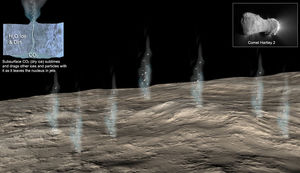
© NASA
An artist's concept of Comet Hartley 2 shows how CO2 jets drag water ice out of nucleus, producing a 'comet snowstorm.'
An artist's concept of Comet Hartley 2 shows how CO2 jets drag water ice out of nucleus, producing a 'comet snowstorm.'
The source of the comet-snow may be the very same garish jets that first caught everyone's eye.
The process begins with dry ice in the comet's crust. Dry ice is solid
CO2, one of Hartley 2's more abundant substances. When heat from the sun
reaches a pocket of dry ice - poof! - it instantly transforms from
solid to vapor, forming a jet wherever local topography happens to
collimate the outrushing gas. Apparently, these CO2 jets are carrying
chunks of snowy water ice along for the ride.
Because the snow is driven by jets, "it's snowing up, not down," notes science team member Peter Schultz of Brown University.
Ironically, flying by Hartley 2 might be more dangerous than actually
landing on it. The icy chunks are moving away from the comet's surface
at only a few m/s (5 to 10 mph). A probe that matched velocity with the
comet's nucleus in preparation for landing wouldn't find the drifting
snowballs very dangerous at all--but a high-speed flyby is another
matter. This is something planners of future missions to active comets
like Hartley 2 will surely take into account.
Comet snowstorms could be just the first of many discoveries to come.
A'Hearn and Sunshine say the research team is only beginning to analyze
gigabytes of data beamed back from the encounter, and new results could
be only weeks or months away.
Stay tuned for updates from Comet Hartley 2.
UK: Anti-Terrorist Cops Assist Probe into Mysterious Explosion in Woodland Near Loch Lomond
Anti-terrorist
officers from the Metropolitan Police have been drafted in to assist an
investigation into an explosion in a remote forest area near Loch
Lomond.
The specialist officers were called in after yesterday's blast in the Garadhban forest in Gartocharn.
Police said the explosion caused damage to trees and it is understood
officers investigating the source of the blast have found several
devices.
The alarm was raised shortly after noon when a member of the public heard the explosion.
UK-wide agencies including the Royal Navy's Northern Diving Group are at
the scene to assist the probe. A Ministry of Defence spokesman said
they had been asked for assistance by Strathclyde Police.
No-one was injured and the public are not at risk, the force said.
Chief Superintendent Calum Murray, Divisional Commander for
Argyll, Bute and West Dunbartonshire, said: "As you would expect, when
we are dealing with a situation where we suspect that explosives may be
involved, it is our immediate priority to assess the situation and to
call on expertise where we think it is appropriate.
"By its very nature, this type of assessment and investigation is
complex and does take time. I can confirm that we are currently being
assisted by agencies from across the UK.
"I would stress that the site is secure and that there is no risk to
public safety. I would ask that if anyone has seen anything suspicious
in or around the area, or has any information - no matter how
insignificant it may seem - that they contact the Police or
Crimestoppers. All calls will, of course, be treated in the strictest of
confidence.
"As I am sure you can understand, this is an ongoing investigation that
is going to take some time to complete. We will release more information
as that investigation progresses."
'Huge ball of fire' actually meteor shower, N.S. officials say
They feared it was a plane crash but it turned out to be a meteor shower lighting up the night sky.
Early Thursday evening, emergency crews rushed to Nova Scotia's South
Shore after getting reports that a "huge ball of fire" had fallen from
the sky near Exit 16 on Highway 103.
RCMP and search and rescue officials were dispatched to the area around Italy Cross.
But after thorough checks, it was determined there had been no plane
crash, Scott Burgwin of the Maritimes Search and Rescue Co-ordination
Centre in Halifax said in an interview.
"We're pretty sure there were no aircraft (in the area)," Burgwin said
just before 8 p.m. "We think it was some sort of natural phenomenon like
a meteor shower."
The call of the "huge ball of fire" came in around 6:30 p.m. from an ambulance driver in the area, said RCMP Sgt. Brigdit Leger.
Burgwin said co-ordination centre officials checked with
Moncton's air traffic control centre and found that no planes had flight
plans for that area, nor did anything show up on radar, Burgwin said.
"We have heard some reports that people saw something," said Michelle
Bishop, spokeswoman for NAV Canada in Ottawa. "We do not have at this
time any missing aircraft."
Contacted earlier in the evening, Halifax International Airport
Authority officials said there were no reports of any delayed flights,
but said that region was outside the agency's area.
Residents in the area contacted by this newspaper hadn't heard anything
and were curious what was going on. One woman working at a restaurant
near Exit 14 said she heard two RCMP cruisers "go flying by here" around
6:45 p.m.
North Carolina, US: Have you heard the area's mysterious booms recently? Tell us where you were
Fri, 19 Nov 2010 14:21 CST
Star News Online
Southeastern North Carolina has been rattled these past few weeks by
mysterious booms that have been heard in Brunswick, Pender and New
Hanover counties. Some folks even reported explosive sounds so loud that
they shook buildings.
No one has determined what is causing the booms, though some have rather
humorous theories. In any case, we want to start keeping track of when
and where these "Seneca Guns," as they're called, are heard.
And we need your help.
Please follow the link below and fill out a short form to tell us when
and where you heard the booms recently. I know many of you posted to
Facebook and Twitter to discuss the events as they were happening, so
those might be a good place to check to refresh your memory of specific
dates and times.
Once we get enough data, we'll start mapping and charting the
booms, which may help paint a better picture of what's going on.
If you want to report multiple booms, you also may e-mail all of the
information requested below for each instance to
jeff.hidek@starnewsonline.com.
Start here.
Thanks! We'll post the map as soon as we get enough data, so please share this link with your friends.
US: Meteor lights up the sky
Sat, 20 Nov 2010 12:27 CST
Global Adventures, LLC
Marietta:
An impressive fireball in the sky could be seen over Marietta, Georgia,
on November 19, 2010 at about 5.15 PM. Two airplanes flew towards the
object that looked like a meteorite descending from west to east on a
low trajectory.
Meteoroids are debris-particles in the solar system. The visible path of
a meteoroid that enters the atmosphere is called a meteor. The remains
of objects that reach the ground and survive the impact are called
meteorite. Most meteors are the size of a pebble and become visible
about 40 and 75 miles (65 and 120 kilometers) above the Earth's surface.
Larger meteors crate a fireball as seen in the picture. While most do
not survive the passage through the atmosphere, some large meteorites
did impact. The resulting craters are usually circular depressions that
have raised rims and floors that are lower than the surrounding terrain.
The
Barringer Crater near Winslow, Arizona, is perhaps the most prominent
impact crater in the U.S. Scientists confirmed that the structure is a
result of a meteorite impact that occurred about 50,000 years ago. The
crater has a diameter of 0.74 miles (1.19 kilometers) and is about 570
feet (170 meters) deep. During the 1960s, NASA astronauts trained in the
crater to prepare for the Apollo missions to the Moon.
The pictures show the meteor as seen from Cobb Parkway on November 19, 2010, and a 100 percent crop of the object.
US: Fireball streaks across the sky in Hawley, Texas
Sun, 21 Nov 2010 01:21 CST
AOL Video
Ice Meteorite Found with Extraterrestrial Life-Forms
Sun, 21 Nov 2010 12:21 CST
24/7 Press Release
South
Haven, Michigan, -- Duane P. Snyder will announce the discovery of the
first and only known ICE METEORITE containing EXTRATERRESTRIAL
LIFE-FORMS on November 30, 2010 at 10:00am at the Ramada Inn Center,
1555 Phoenix Road, South Haven, MI 49090.
Also to be announced: The ICE METEORITE's particle analysis, it's gas
analysis, where it likely came from and PHOTOS of EXTRATERRESTRIAL
LIFE-FORMS found in the melt-water of the ICE METEORITE.
Dr.
Albert Schnieders of Tascon USA Inc, Chestnut Ridge, New York 10977,
has commented that we basically found nearly all elements up to 90u in
the sample spherical particles.
snydericyrite.com is a website dedicated to releasing information on the
Ice meteorite found in year 2000 and the extraterrestrial life forms
found in it. For further information, please contact us at
duanepsnyder@snydericyrite.com
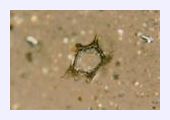
© 24/7 Press Release
Boney structure part of a life-form.
Canada: Great balls of fire?
County - A bright sight in the skies in the western part of Lunenburg
County during the November 18 supper hour is said to be part of the
Leonid meteor shower.
There was information from an ambulance travelling in the Italy Cross area reporting a fireball had fallen from the sky.
Initial radio dispatches indicated a possible plane crash had happened.
Paramedics were placed on standby as police rushed to find out more
details.
But the authorities came up with nothing. Police and Halifax's joint
rescue co-ordination centre (JRCC) later confirmed no aircraft were
missing, nor had any hit the ground.
"We checked through JRCC and there's no aircraft anywhere in the area,
there's no radar contacts of any kind and it was at the height of the
meteor shower," Lunenburg County RCMP Cpl. Don Gray said.
He said the paramedic saw "something burning in the sky," but it disappeared quickly.
A meteor theory appears to be the best explanation, said Chris Rutkowski, a Manitoba-based UFO researcher.
"The timing is right since the peak was [November 18] morning," he said.
The Leonid meteor shower happens each year around this time. It's named
after the constellation Leo and occurs in association with a comet.
Mr. Rutkowski said, as of early November 19, he hadn't received any reports related to the South Shore sky light show.
"The description of the object as a plane crash is typical and also that
the flaming object seemed to fall to the ground a short distance away,"
he added.
"In reality, the fireball was high in the atmosphere, probably about 25
to 50 kilometres up, and was between a basketball and a bar fridge in
size."
The Sun Steals Comets from Other Stars
The next time you thrill at the sight of a comet blazing across the
night sky, consider this: it's a stolen pleasure. You're enjoying the
spectacle at the expense of a distant star.

Sophisticated computer simulations run by researchers at the Southwest Research Institute (SWRI) have exposed the crime.
"If the results are right, our Sun snatched comets from neighboring
stars' back yards," says SWRI scientist Hal Levison. And he believes
this kind of thievery accounts for most of the comets in the Oort Cloud
at the edge of our solar system.
"We know that stars form in clusters. The Sun was born within a huge
community of other stars that formed in the same gas cloud. In that
birth cluster, the stars were close enough together to pull comets away
from each other via gravity. It's like neighborhood children playing in
each others' back yards. It's hard to imagine it not happening."
According to this "thief" model, comets accompanied the nearest star
when the birth cluster blew apart. The Sun made off with quite a
treasure - the Oort Cloud, which was swarming with comets from all
over the "neighborhood."
The Oort cloud is an immense cloud of comets orbiting the Sun far beyond
Pluto. It is named after mid-20th century Dutch astronomer Jan Oort,
who first proposed such a cloud to explain the origin of comets
sometimes seen falling into the inner solar system. Although no
confirmed direct observations of the Oort cloud have been made, most
astronomers believe that it is the source of all long-period and
Halley-type comets.
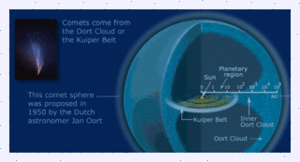
The standard model of comet production asserts that our Sun came by these comets honestly.
"That model says the comets are dregs of our own solar system's
planetary formation and that our planets gravitationally booted them to
huge distances, populating the cloud. But we believe this kind of
scenario happened in all the solar systems before the birth cluster
dispersed."
Otherwise, says Levison, the numbers just don't add up.
"The standard model can't produce anywhere near the number of comets we
see [falling in from the Oort Cloud]. The Sun's sibling stars had to
have contributed some comets to the mix."
Comets
in the Oort Cloud are typically 1 or 2 miles across, and they're so far
away that estimating their numbers is no easy task. But Levison and his
team say that, based on observations, that there should be something
like 400 billion comets there. The "domestic" model of comet formation
can account for a population of only about 6 billion.
"That's a pretty anemic Oort Cloud, and a huge discrepancy - too huge
to be explained by mistakes in the estimates. There's no way we could be
that far off, so there has to be something wrong with the model
itself."
He points to the cometary orbits as evidence.
"These comets are in very odd orbits - highly eccentric long-period
orbits that take them far from our Sun, into remote regions of space. So
they couldn't have been born in orbit around the Sun. They had to have
formed close to other stars and then been hijacked here."
This means comets can tell us not only about the early history of the Sun - but also about the history of other stars.
"We can study the orbits of comets and put their chemistry into the
context of where and around which star they formed. It's intriguing to
think we got some of our 'stuff' from distant stars. We're kin."
Space Debris? Russia's Got It Covered
Russia has announced
it will be investing $2 billion in a program to capture some of the
thousands of pieces of dangerous debris that threaten the future of
space technology. How might it work?
Energia, Russia's space corporation, has revealed plans
to build a special space "pod" which will grab around 600 defunct
satellites and then safely deorbit them so that they either burn up in
the atmosphere or splash down into the ocean. The pod will rely on a
nuclear power core, and cost around $2 billion to develop and deploy.
Energia plans to complete design and testing by 2020 and have it in
service no later than 2023, with an operational lifespan of around 15
years. The company also said it has been working on a space interceptor
capable of tackling any dangerous objects from the outer solar system
that may be on a collision course with Earth.
If it seems odd to think of Russia as Earth's space junk and comet
defender, it's also welcome news. Space debris in the form of defunct or
malfunctioning satellites is an increasingly severe
problem. Numerous orbits are becoming inaccessible, or at least
hopelessly dangerous, because of wandering hulls or showers of shredded
metal debris--like the one caused by a collision between a working U.S. Iridium satellite and a dead Russian Cosmos satellite in 2009.
How might the system operate? Energia hasn't offered much in
the way of details, but its long mission life span and nuclear power
source point to its drive tech. Radio thermal space waves can generate
electricity over a long time, making it an ideal power source for ion
drives (which use electric fields to accelerate ionized gas, rather than
the typical chemical rockets). The pod's stated targets, dead
satellites, also suggests it won't use an exotic form
of debris capture, like a space net. Instead it's more likely to power
its way up to a dead satellite in or near its main orbit, and then use
the ion drive to gently push the spent vehicle into a decaying orbit
that'll end with a burn-up.
Similar technology could be used in the "interceptor" spacecraft, only on a bigger scale. If
you can identify and encounter an incoming threatening comet in time,
you may only need to deviate its trajectory by a tiny amount so that it
misses Earth rather than hits it.
Of course, the technology for both a debris pod and comet interceptor
would also make those particular spacecraft very potent anti-satellite
weapons in a hypothetical space war. But we're probably better off not
thinking too much about that.
US: Fireball Over Tampa
Jet, Fireball, Meteor, space junk, or UFO?
Several Polk County viewers called yesterday evening to report something in the sky over Tampa Bay, Florida.
The callers believed the object may have been a meteor or other object entering Earth's atmosphere.
Photos sent by one viewer showed the bright object with some sort of
vapour or smoke trail behind it. They were taken at around 5:45 pm.
It's not clear if the object was a passenger jet with its exhaust trail
illuminated by the setting sun, or if it was a meteor or piece of space
junk being burned up as it entered the atmosphere.
Boney structure part of a life-form.
Canada: Great balls of fire?
County - A bright sight in the skies in the western part of Lunenburg
County during the November 18 supper hour is said to be part of the
Leonid meteor shower.
There was information from an ambulance travelling in the Italy Cross area reporting a fireball had fallen from the sky.
Initial radio dispatches indicated a possible plane crash had happened.
Paramedics were placed on standby as police rushed to find out more
details.
But the authorities came up with nothing. Police and Halifax's joint
rescue co-ordination centre (JRCC) later confirmed no aircraft were
missing, nor had any hit the ground.
"We checked through JRCC and there's no aircraft anywhere in the area,
there's no radar contacts of any kind and it was at the height of the
meteor shower," Lunenburg County RCMP Cpl. Don Gray said.
He said the paramedic saw "something burning in the sky," but it disappeared quickly.
A meteor theory appears to be the best explanation, said Chris Rutkowski, a Manitoba-based UFO researcher.
"The timing is right since the peak was [November 18] morning," he said.
The Leonid meteor shower happens each year around this time. It's named
after the constellation Leo and occurs in association with a comet.
Mr. Rutkowski said, as of early November 19, he hadn't received any reports related to the South Shore sky light show.
"The description of the object as a plane crash is typical and also that
the flaming object seemed to fall to the ground a short distance away,"
he added.
"In reality, the fireball was high in the atmosphere, probably about 25
to 50 kilometres up, and was between a basketball and a bar fridge in
size."
The Sun Steals Comets from Other Stars
The next time you thrill at the sight of a comet blazing across the
night sky, consider this: it's a stolen pleasure. You're enjoying the
spectacle at the expense of a distant star.

© NASA
A cluster of stars forming in the Orion nebula. According to Hal Levison's research, these stars could be swapping comets.
A cluster of stars forming in the Orion nebula. According to Hal Levison's research, these stars could be swapping comets.
Sophisticated computer simulations run by researchers at the Southwest Research Institute (SWRI) have exposed the crime.
"If the results are right, our Sun snatched comets from neighboring
stars' back yards," says SWRI scientist Hal Levison. And he believes
this kind of thievery accounts for most of the comets in the Oort Cloud
at the edge of our solar system.
"We know that stars form in clusters. The Sun was born within a huge
community of other stars that formed in the same gas cloud. In that
birth cluster, the stars were close enough together to pull comets away
from each other via gravity. It's like neighborhood children playing in
each others' back yards. It's hard to imagine it not happening."
According to this "thief" model, comets accompanied the nearest star
when the birth cluster blew apart. The Sun made off with quite a
treasure - the Oort Cloud, which was swarming with comets from all
over the "neighborhood."
The Oort cloud is an immense cloud of comets orbiting the Sun far beyond
Pluto. It is named after mid-20th century Dutch astronomer Jan Oort,
who first proposed such a cloud to explain the origin of comets
sometimes seen falling into the inner solar system. Although no
confirmed direct observations of the Oort cloud have been made, most
astronomers believe that it is the source of all long-period and
Halley-type comets.

© ESO
An
artist's concept of the Oort cloud. Note that the distance scale is
logarithmic. Compared to the size of planetary orbits, the Oort cloud is
very far away. Indeed, the estimated size of the Oort cloud, 10^5 AU,
is approximately 1 light year. If the Sun passed within 2 light years of
another sun-like star, the stars' Oort clouds would overlap and their
comets would intermingle.
An
artist's concept of the Oort cloud. Note that the distance scale is
logarithmic. Compared to the size of planetary orbits, the Oort cloud is
very far away. Indeed, the estimated size of the Oort cloud, 10^5 AU,
is approximately 1 light year. If the Sun passed within 2 light years of
another sun-like star, the stars' Oort clouds would overlap and their
comets would intermingle.
The standard model of comet production asserts that our Sun came by these comets honestly.
"That model says the comets are dregs of our own solar system's
planetary formation and that our planets gravitationally booted them to
huge distances, populating the cloud. But we believe this kind of
scenario happened in all the solar systems before the birth cluster
dispersed."
Otherwise, says Levison, the numbers just don't add up.
"The standard model can't produce anywhere near the number of comets we
see [falling in from the Oort Cloud]. The Sun's sibling stars had to
have contributed some comets to the mix."
Comets
in the Oort Cloud are typically 1 or 2 miles across, and they're so far
away that estimating their numbers is no easy task. But Levison and his
team say that, based on observations, that there should be something
like 400 billion comets there. The "domestic" model of comet formation
can account for a population of only about 6 billion.
"That's a pretty anemic Oort Cloud, and a huge discrepancy - too huge
to be explained by mistakes in the estimates. There's no way we could be
that far off, so there has to be something wrong with the model
itself."
He points to the cometary orbits as evidence.
"These comets are in very odd orbits - highly eccentric long-period
orbits that take them far from our Sun, into remote regions of space. So
they couldn't have been born in orbit around the Sun. They had to have
formed close to other stars and then been hijacked here."
This means comets can tell us not only about the early history of the Sun - but also about the history of other stars.
"We can study the orbits of comets and put their chemistry into the
context of where and around which star they formed. It's intriguing to
think we got some of our 'stuff' from distant stars. We're kin."
Space Debris? Russia's Got It Covered
Russia has announced
it will be investing $2 billion in a program to capture some of the
thousands of pieces of dangerous debris that threaten the future of
space technology. How might it work?
Energia, Russia's space corporation, has revealed plans
to build a special space "pod" which will grab around 600 defunct
satellites and then safely deorbit them so that they either burn up in
the atmosphere or splash down into the ocean. The pod will rely on a
nuclear power core, and cost around $2 billion to develop and deploy.
Energia plans to complete design and testing by 2020 and have it in
service no later than 2023, with an operational lifespan of around 15
years. The company also said it has been working on a space interceptor
capable of tackling any dangerous objects from the outer solar system
that may be on a collision course with Earth.
If it seems odd to think of Russia as Earth's space junk and comet
defender, it's also welcome news. Space debris in the form of defunct or
malfunctioning satellites is an increasingly severe
problem. Numerous orbits are becoming inaccessible, or at least
hopelessly dangerous, because of wandering hulls or showers of shredded
metal debris--like the one caused by a collision between a working U.S. Iridium satellite and a dead Russian Cosmos satellite in 2009.
How might the system operate? Energia hasn't offered much in
the way of details, but its long mission life span and nuclear power
source point to its drive tech. Radio thermal space waves can generate
electricity over a long time, making it an ideal power source for ion
drives (which use electric fields to accelerate ionized gas, rather than
the typical chemical rockets). The pod's stated targets, dead
satellites, also suggests it won't use an exotic form
of debris capture, like a space net. Instead it's more likely to power
its way up to a dead satellite in or near its main orbit, and then use
the ion drive to gently push the spent vehicle into a decaying orbit
that'll end with a burn-up.
Similar technology could be used in the "interceptor" spacecraft, only on a bigger scale. If
you can identify and encounter an incoming threatening comet in time,
you may only need to deviate its trajectory by a tiny amount so that it
misses Earth rather than hits it.
Of course, the technology for both a debris pod and comet interceptor
would also make those particular spacecraft very potent anti-satellite
weapons in a hypothetical space war. But we're probably better off not
thinking too much about that.
US: Fireball Over Tampa
Jet, Fireball, Meteor, space junk, or UFO?
Several Polk County viewers called yesterday evening to report something in the sky over Tampa Bay, Florida.
The callers believed the object may have been a meteor or other object entering Earth's atmosphere.
Photos sent by one viewer showed the bright object with some sort of
vapour or smoke trail behind it. They were taken at around 5:45 pm.
It's not clear if the object was a passenger jet with its exhaust trail
illuminated by the setting sun, or if it was a meteor or piece of space
junk being burned up as it entered the atmosphere.
.
Meteor,space junk, jet, or ufo?
Fri, 26 Nov 2010 12:01 CST
Fox 13
Lakeland, Florida - Several Polk County viewers called FOX 13 yesterday evening to report something in the sky.
The callers believed the object may have been a meteor or other object entering Earth's atmosphere.
Photos sent by one viewer showed the bright object with some sort of
vapor or smoke trail behind it. They were taken at around 5:45 p.m.
It's not clear if the object was a passenger jet with its exhaust trail
illuminated by the setting sun, or if it was a meteor or piece of space
junk being burned up as it entered the atmosphere.
FOX 13 has been unable to reach any experts who could confirm either theory.
Two weeks ago, video taken by a news helicopter near Los Angeles created a buzz
when it appeared to show a mystery missile being launched from the
Pacific Ocean. The military later determined it was likely an aircraft's
contrail being illuminated by the evening sun.
US: Mystery Blast Likely a Sonic Boom, Official Says
Was it an explosion? An earthquake? A Klingon attack vessel?
Residents of Carroll, Douglas and Haralson counties, west of Atlanta,
heard a big boom last night, and officials for all three counties spent
considerable effort trying to figure out what caused it.
They're still trying.
Douglas County Communication Director Wes Tallon said "911 calls lit up"
the switchboard after the 9:45 p.m. mystery noise rattled windows
across a large area of west Georgia.
"There was no catastrophe, we know that," said Tallon early Saturday
morning, who said the public did not report any fires or explosions.
And no utility companies reported trouble either. "We've called everyone
under the sun trying to figure this one out," said Tallon. "We used the
process of elimination and the only thing we can think of is that is
was a sonic boom of some kind. To be able to be heard and felt 30 miles
away in Haralson County it had to be something like that."
A sonic boom is a large shock wave created by an aircraft that exceeds the sound barrier, about 761 mph.
Tallon said he lives in East Douglas and did not hear the blast while
watching football. But plenty of people did in the western area of the
county and in Carroll and Haralson counties further to the west.
Villa Rica authorities dispatched several police and fire units to the
Mirror Lake subdivision in the city, but found no damage or even smoke.
"People all over the city heard the boom, but we couldn't find anything," a police department receptionist said.
'Fireball' Lights up Northern Ireland Sky
Mon, 29 Nov 2010 12:10 CST
BBC, UK
A fireball was spotted in the skies over Northern Ireland on Sunday evening, Armagh Observatory has said.
A spokesman said they had been "inundated "with calls about an object in the sky which was on fire.
A caller from Coleraine said the object burned bright yellow and orange and had a long tail.
A caller from County Down said it was a ball of fire.
The Observatory spokesman said it was probably a piece of space debris,
either man-made "space junk" or a small asteroid or fragment of a comet,
entering the Earth's atmosphere at many kilometres a second.
It may well have finally burned up over the North Atlantic Ocean off the Donegal coast.
Reports of the fireball can be viewed as a link from the Armagh Observatory website.
The Armagh Observatory has appealed to anyone operating north-pointing
CCTV cameras to inspect video footage recorded between approximately
1730 GMT and 1800 GMT on Sunday 28 November.
"If enough video footage from different parts of Northern Ireland is
found, then it may be possible to determine the nature and origin of the
impacting object," the spokesman said.
Experts may then be able to establish what the object's original orbit
in the solar system might have been and whether it was part of a
previously known meteor shower.
US: Mystery Sonic Boom Rattles Georgia
In
the evening hours, residents of three Georgia counties, Carroll,
Douglas, and Haralson, were settling down to a relaxing
post-Thanksgiving Friday. Then, their night was shattered by a huge
explosion. The noise is easily explained away, but the cause remains to
be determined. When an airplane travels faster than the speed of sound,
the resulting noise is a horrifying explosive thunder known as a sonic
boom. Usually, the only airplanes breaking the sound barrier are military aircraft,
but according to the FAA, there are no military flyover zones in the
area of Georgia where the mysterious sonic boom was heard. Rural
Georgia was rocked by a sonic boom that seems to have no cause.
Not only were there no military aircraft in the area, there were also no meteors spotted, according to amateur astronomer Michael Covington. There were no bright lights that would be associated with a meteor, no explosions, and no damage to anything in the area where the booming was heard.
Douglas County Communication Director Wes Tallon was left
grasping for explanations as to just what tore a hole in the Georgia
sky. "There was no catastrophe, we know that," Tallon told the Atlanta
Journal Constitution. "We've called everyone under the sun trying to
figure this one out. We used the process of elimination and the only
thing we can think of is that it was a sonic boom of some kind. To be
able to be heard and felt 30 miles away in Haralson County it had to be
something like that."
How About This Theory: Villa Rica Bang Was a Meteor?
Was it a meteor?
How about two?
The mysterious big bang that has been the talk of Villa Rica and the
surrounding three-county area since it occurred Friday night is still
unexplained, though some think they know what it was and others say it
wasn't the first unexplained sound in the area.
Some people have contacted the AJC saying they saw a large
meteor around the same time as the noise, and others say a meteor can
make a sonic boom if it gets close enough to the ground.
But if that's what made the loud sound heard in Carroll, Douglas and
Haralson counties around 9:45 p.m., then what caused a similar noise two
weeks earlier?
Several people have contacted the AJC to say that the recent explosion was preceded by a slightly quieter one on, or around, Nov. 13.
"It's so weird," said Sandra Harper, who lives in the Mirror
Lake subdivision in Villa Rica, which was apparently ground zero for the
latest blast. "Everybody got in a stew about this one but there was
apparently no stew about the first one."
Harper said both explosions were hearty enough to rattle the windows on
her home. After the first one, she ran to her deck, imagining that a
house in the neighborhood had blown up from an ignition of natural gas.
She looked for smoke and waited for sirens. But when she saw and heard
nothing, she went back inside. No one but her husband mentioned to her
that they had heard it.
The next boom two weeks later caught the attention of far more people, it seems.
Douglas County Communication Director Wes Tallon said last weekend that
"911 calls lit up" the switchboard after it shook houses across west
Georgia.
Villa Rica authorities dispatched several police and fire units to the
Mirror Lake neighborhood when the sound was first reported, but they
found no smoke or damage.
Local authorities speculated that it was a sonic boom made by an
aircraft exceeding the speed of sound, 761 mph. But a Federal Aviation
Administration spokeswoman told the AJC that no commercial aircraft can
travel that fast. Only military airplanes can make a sonic boom, and
there are no military flight zones in the vicinity of the explosion and
there was no record of military flights there at the time, said the FAA
spokeswoman, Kathleen Bergen.
An avid star gazer who contacted the AJC said some meteors that
made it close enough to earth could make a sonic boom. But given the
relatively cloudless skies around the time of Friday's explosion, people
should have seen it, Michael Covington, an amateur astronomer who has
published several books about sky-watching, told the AJC last weekend.
"A really big meteor can make a sonic boom, but if it did, it would make
a big flash of light," said Covington, who helps run a computer
research program at the University of Georgia when he's not pursuing his
hobby.
The local authorities didn't mention any reports of flashes overhead, but several people from the area have contacted the AJC saying they saw a bright light in the sky around the time of the explosion.
"It just looked like a big white ball," said Susan Burns, who lives on a
sparsely populated ridge in south Paulding County. It was mottled,
white and gray, like the moon, and it had a long tail, she said. "It was at least 10 times bigger than any other shooting star I've ever seen."
Burns lives near the Douglas County line and said the meteor appeared to
fall straight down, to the west of her, and to the north of the Mirror
Lake neighborhood. It was around 9:30 p.m. or 9:40 p.m., she recalled.
She found Covington after reading his comment in the AJC. They
communicated by e-mail, and he told her that she must have seen the
source of the explosion. It's possible that she wouldn't have heard
anything because of the meteor's trajectory, he explained.
So maybe that's what happened. And maybe, in a freak coincidence,
another big meteor fell in the same way, in the same place, unnoticed,
two weeks earlier.
Or maybe there is still some other explanation out there.
Maybe it was a military pilot "who was having fun and not telling anybody," speculated Harper, the Mirror Lake resident.
Whatever it was, she said she hopes it doesn't return:
"I'll be concerned if, in two weeks, I hear the same sound again."
Comment: The Mirror Lake resident may have reason to be concerned:
See: Forget About Global Warming: We're One Step From Extinction!
Dark Jupiter May Haunt Edge of Solar System
Mon, 29 Nov 2010 23:41 CST
All Top News
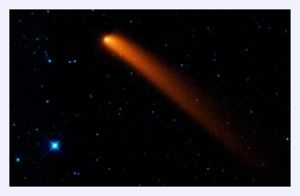
© NASA/JPL-Caltech/UCLA
Comet Sliding Spring, a visitor from the Oort Cloud, was captured by WISE in Jan. 2010.
Comet Sliding Spring, a visitor from the Oort Cloud, was captured by WISE in Jan. 2010.
A century of comet data suggests a dark, Jupiter-sized object is
lurking at the solar system's outer edge and hurling chunks of ice and
dust toward Earth.
"We've accumulated 10 years more data, double the comets we viewed to test this hypothesis," said planetary scientist John Matese
of the University of Louisiana. "Only now should we be able to falsify
or verify that you could have a Jupiter-mass object out there."
In 1999, Matese and colleague Daniel Whitmire suggested the sun has a hidden companion that boots icy bodies from the Oort Cloud, a spherical haze of comets at the solar system's fringes, into the inner solar system where we can see them.
In a new analysis of observations dating back to 1898, Matese and
Whitmire confirm their first thought: In this area 20 percent of the
comets visible from Earth were sent by a dark, distant planet.
This thought was a reaction to an earlier notion that a dim brown dwarf or red dwarf star, ominously dubbed Nemesis,
has pummeled the Earth with deadly comet showers every 30 million years
or so. Shortly research suggested that mass extinctions on Earth don't
line up with Nemesis's predictions, so many astronomers now reckon the
object doesn't exist.
"But we started to question, what kind of an object could you hope
to infer from the bestow data that we are seeing?" Matese said. "What
could possibly tickle [comets'] orbits and make them come very close to
the sun so we could see them?"
Rather than a malevolent death star, a smaller and more benign companion called Tyche (Nemesis's excellent sister in Greek mythology) could send comets streaming from the Oort Cloud toward Earth.
The cosmic snowballs that form the hearts of comets generally hang out
in the Oort Cloud until their orbits are nudged by some outside force.
This push could come from one of three things, Matese says. The constant
gravitational pull of the Milky Way's disk can drag comets out of their
icy homes and into the inner solar system. A quick star can shake
comets loose from the Oort Cloud as it zips by. Or a large companion like Nemesis or Tyche can pull comets out of their comfort zones.
Computational models show that comets in each of these scenarios, when
their obvious origins are mapped in space, make a characteristic pattern
in the sky.
"We looked at the patterns and questioned, 'Is there bonus proof of a
pattern that might be associated with a quick star or with a bound
object?'" Matese said.
After examining the orbits of more than 100 comets in the Minor Planet Center
database, the researchers concluded that 80 percent of comets born in
the Oort Cloud were pushed out by the galaxy's gravity. The left over 20
percent, but, needed a nudge from a distant object in this area 1.4
times the mass of Jupiter.
"Something smaller than Jovian mass wouldn't be strong enough to do the
deed," Matese said. "Something more fantastic, like a brown dwarf, would
give a much stronger signal than the 20 percent we assert."
There's one problem, though. The pattern only works for comets that come
from the spherical outer Oort Cloud, which extends from in this area
0.3 to 0.8 light-years from the sun. Comets from the flatter, more
donut-shaped inner Oort Cloud don't make the same distinctive pattern.
"That's troubling," Matese said. "It requires an entirely new dynamical
description for how inner Oort Cloud comets are made observable."
That the same weird pattern from 1999 is still there now "certainly
makes it a stronger case than past papers," said planetary scientist Nathan Kaib
of the Canadian Institute for Theoretical Astrophysics, who was not
involved in the new work. But he would still like to see more data.
"I reckon this whole issue will be resolved in the next 5 to 10 years,
since there's surveys coming on line ... that will dwarf the comet
sample we have now," he said. "Whether these types of asymmetries in the
directions that comets are coming from really do exist or not will
certainly be hammered out by persons surveys."
We may not have to wait that long, Matese says. An object like Tyche
could be seen frankly by WISE, NASA's infrared space telescope.
"We anticipate that this WISE is going to falsify or verify our conjecture," he said. "We just have to be patient."
Mystery of Green Fireball 'UFOs' Solved?
Tue, 30 Nov 2010 21:05 CST
Charles Q. Choi
LiveScience

© Courier Mail / Channel 9 TV
Green fireballs seen in the Australian sky were captured in photos, this one taken by a member of the public in Brisbane.
Green fireballs seen in the Australian sky were captured in photos, this one taken by a member of the public in Brisbane.
Green
fireballs that streaked across the sky and rolled down an Australian
mountainside four years ago, spurring reports of UFOs in the area, might
have been meteors and ball lightning, a researcher suggests.
At least three traffic-light green fireballs brighter than the moon but
not as bright as the sun blazed over northeast Australia on May 16,
2006. A farmer saw one with a blue tapering tail pass over the mountains
of the Great Divide about 75 miles (120 kilometers) west of Brisbane,
then watched a phosphorescent green ball about 12 inches wide (30
centimeters) roll slowly down the side of a mountain, bouncing over a
rock along the way.
Green fireballs have been seen many times in the sky, and are typically
explained as meteors whose shockwaves lead to electrically charged
oxygen similar to that seen in auroras. In fact, a commercial airline
pilot who landed in New Zealand that day reported seeing a meteor breaking up into fragments, which turned green as the bits descended in the direction of Australia.
The timing of the fireballs suggests they might have been debris from
Comet 73P/Schwassmann - Wachmann 3, said physicist Stephen Hughes at the
Queensland University of Technology in Brisbane.
The green ball the farmer saw roll down the slope was almost
certainly not a meteorite, Hughes said. No perfectly round meteorite a
foot wide has ever been found, and if it were one, it wouldn't be
rolling slowly down a hill.
Instead, Hughes suggests it might have been ball lightning, mysterious
glowing orbs of light usually seen during thunderstorms. The green
fireball might have provided an electrical connection between the ground
and the ionized layer of atmosphere known as the ionosphere, providing
the energy needed for ball lightning.
Meteors are often mistaken for UFOs, as are lightning, balloons and military experiments.
Comment: And Chinese lanterns.
"A transient electrical link between the ionosphere and ground,
created by meteors or some other means, could help to solve the mystery
of many UFO sightings," Hughes told LiveScience. "Since such balls would
be very insubstantial they would be able to move and change direction
very fast as has often been observed."
Hughes detailed his findings online Nov. 30 in the Proceedings of the Royal Society A.
Comment: The reader may enjoy a more in-depth look at fireballs: Meteorites, Asteroids, and Comets: Damages, Disasters, Injuries, Deaths, and Very Close Calls
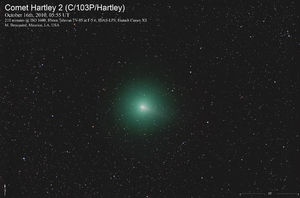
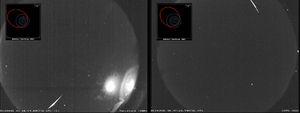

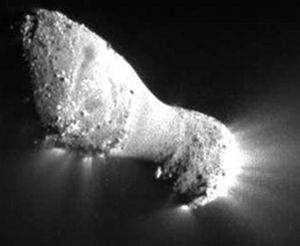
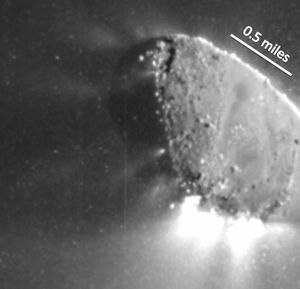

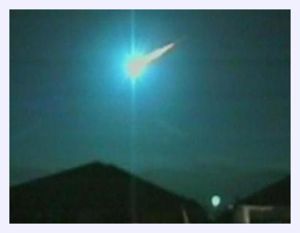
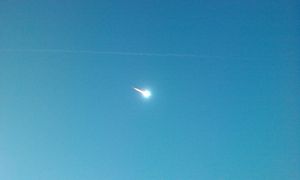
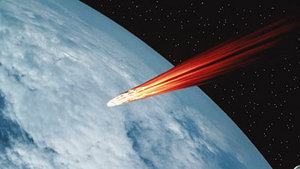


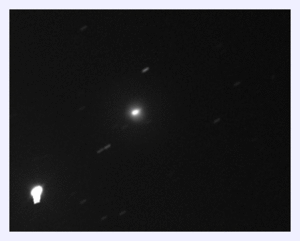
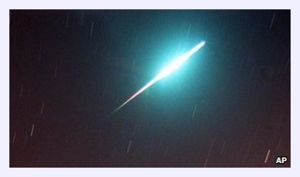
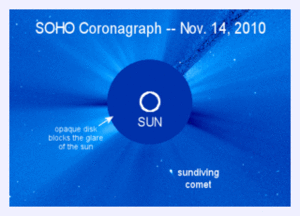
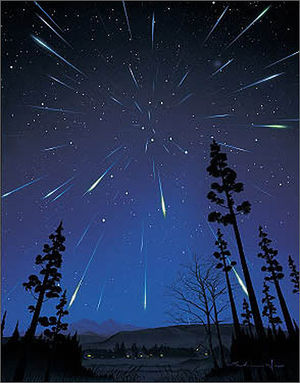
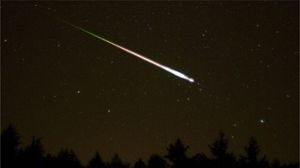

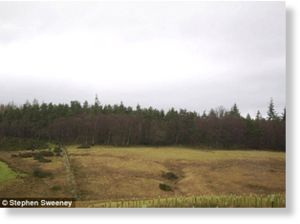
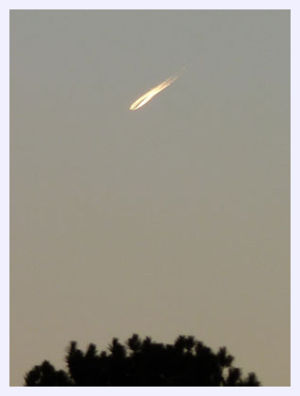
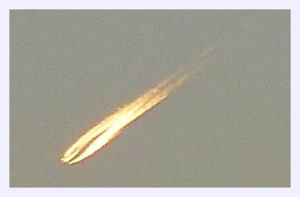


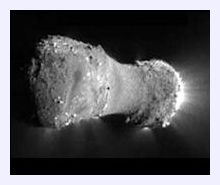

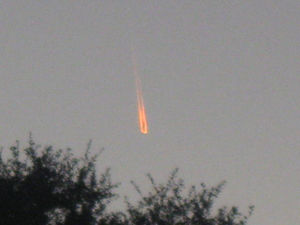
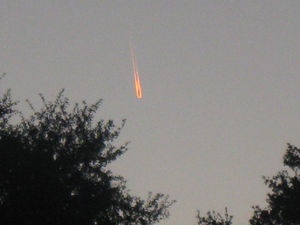
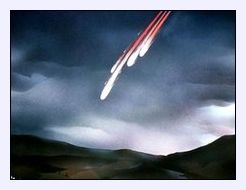
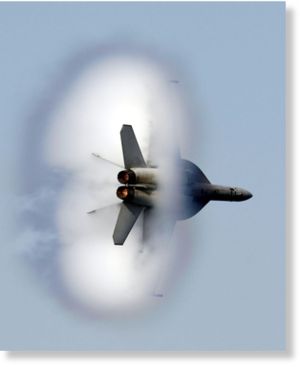
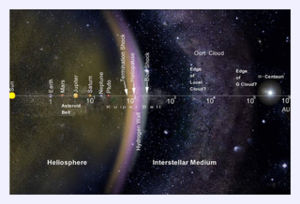
No comments:
Post a Comment